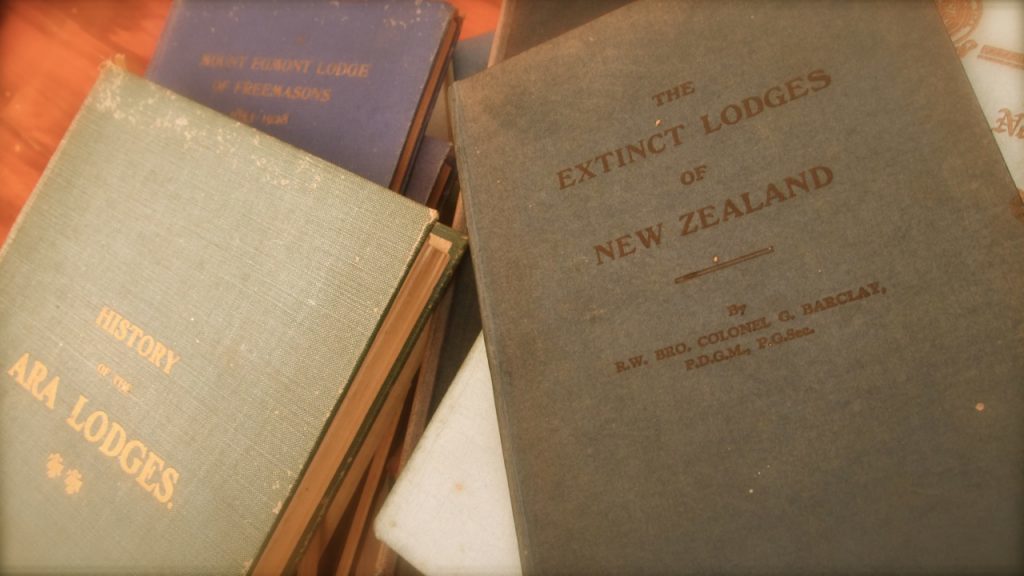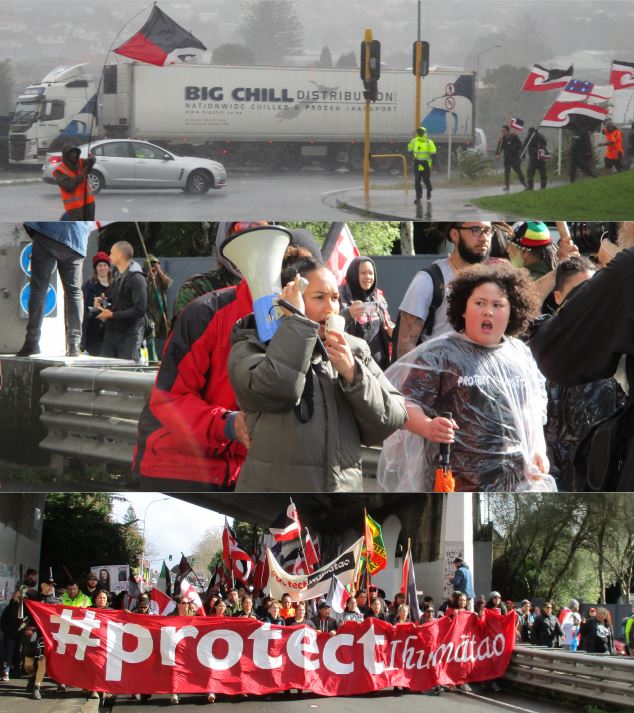
Words & Hikoi Photos by Snoopman, 26 August 2019
Ahi Kaa Kaitiaki cast as ‘Squatters’
Let me decipher how New Zealand’s Pākehā-dominated ruling class uses buck-passing, stealthy paternalism and polite institutional racism through the case of the land dispute at Ihumātao.
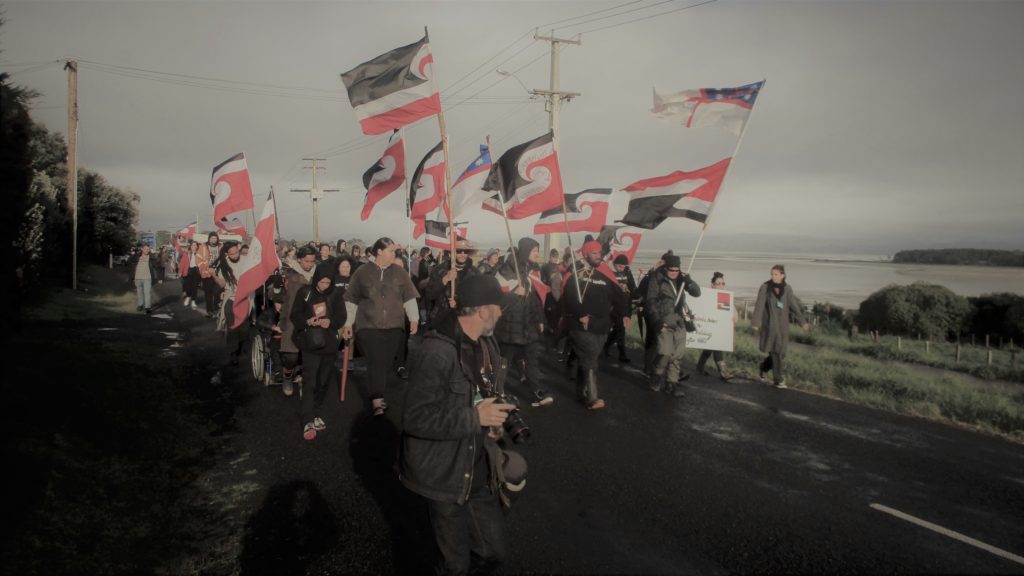
The fight over the ownership of land at Ihumātao in Mangere, just five minutes drive from the Auckland International Airport, reveals New Zealand’s Neo-Colonial Crown plays a delicate game to avoid facing its responsibilities. Consequentially, the Ihumātao occupation group, Save Our Unique Landscapes (SOUL), organized a hikoi or long-walk from the Ihumātao Peninsula, which is located on the shores of the Manukau Harbour, to the Prime Minister’s electorate office in Morningside – 18 kilometres away.
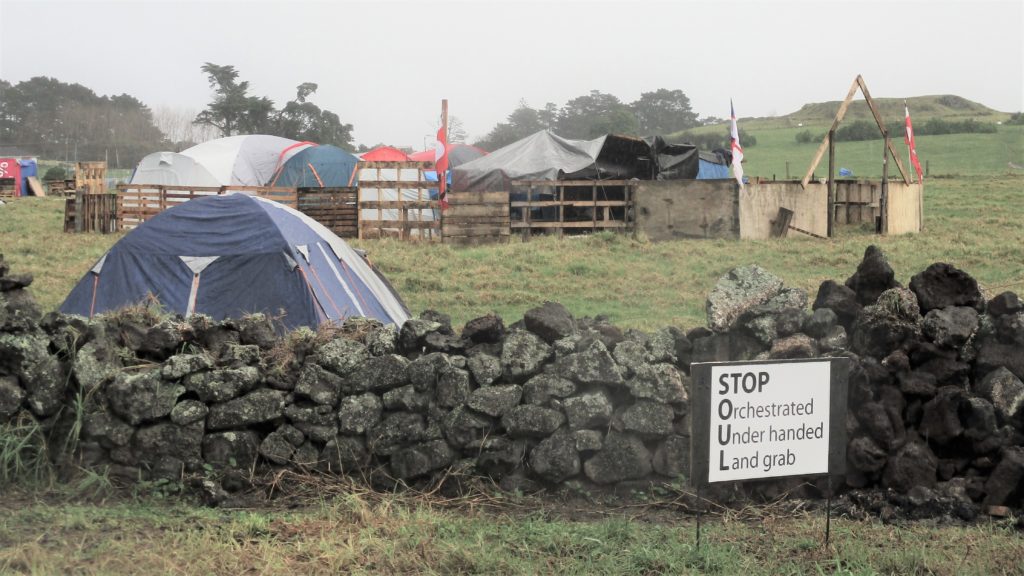
Fletcher Building consortium bought the 81-acre paddocked property off Gavin H Wallace Limited in March 2014 for a sum of $19 million. Fletcher Building’s subsidiary Fletcher Residential plans to develop the site for residential housing next to the Puketaapapa volcano at the edge of the Otuataua Stonefields Historic Reserve – that the manu whenua of Ihumātao consider sacred. The land was formerly confiscated by the Colonial Crown through its Executive Orders in Council in 1865, after Māori were served an ultimatum to take an oath of allegiance to Queen Victoria and hand in their weapons, or leave under threat of ejection. The disputed 81 acre (or 32 hectare) Oruarangi Block was bought for £658 by Scottish Methodist, Gavin Struthers Wallace, at an auction held by the Waste Lands Office on the 17th of July 1866. This sale was subsequently sealed by a Crown Grant on 28th December of 1867 – which bears the signature of no less a figure that the Governor of the Colony and Commander-in-Chief of the Armed Forces, Freemason Bro. George Grey. The protest group SOUL, who view themselves as kaitiaki, or whenua protectors, argue that the Crown ought to be at the centre of the resolution, since it was their Colonial incarnation that confiscated the land off their ancestors in 1863 on the slanderous claim that ‘the Natives’ were in rebellion.
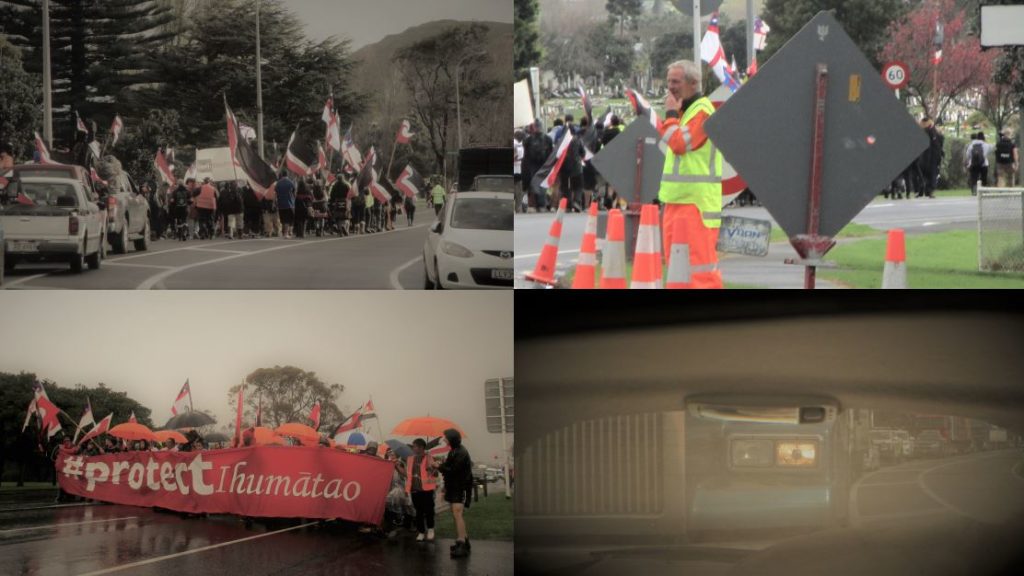
Ever since a Court Bailiff moved on the 32-hectare Oruarangi Block at Ihumātao on Tuesday July 23 2019 – with the support of 200 Police – to evict an occupation group numbering 10, New Zealand’s Prime Minister Jacinda Ardern has stated that a resolution needs to be found by other people, particularly Māori. First, Ardern’s solution framing emphasized the need for mana whenua to resolve the issue, which implied the problem was really that those Māori with ancestral links to the land needed to accept that the whenua was now lost forever to a development consortium whom plan to build houses.
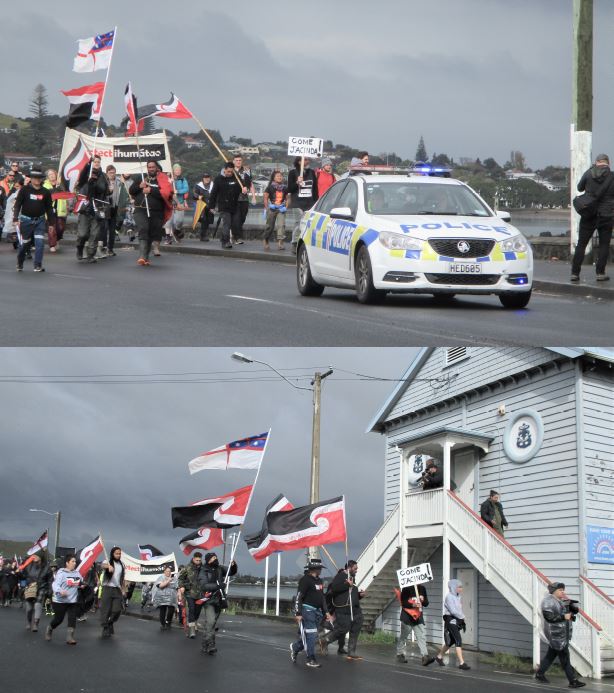
But within a few days, thousands of supporters made pilgrimages out to the ‘frontline’. The story captured national media attention. Ihumātao became the most searched word on the internet in New Zealand. People began sending food, firewood and money to support the re-occupation of the whenua or land.
Framing Te News
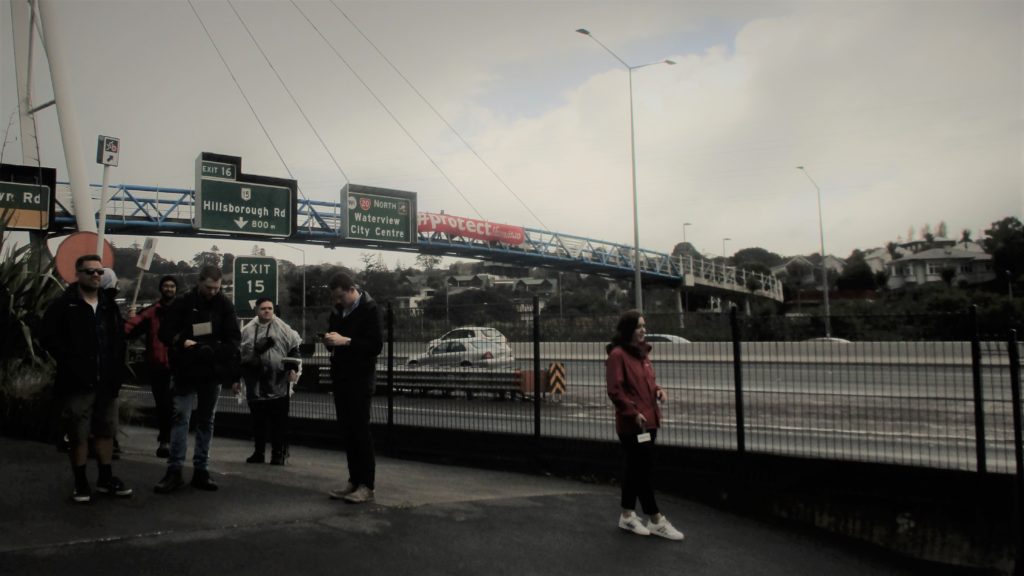
Prime Minster Ardern announced late on Friday 26th July that no construction would start until a solution was found. Ardern claimed the issue was really a problem between rangatahi, or youth, and their kaumatua and kuia, or elders.
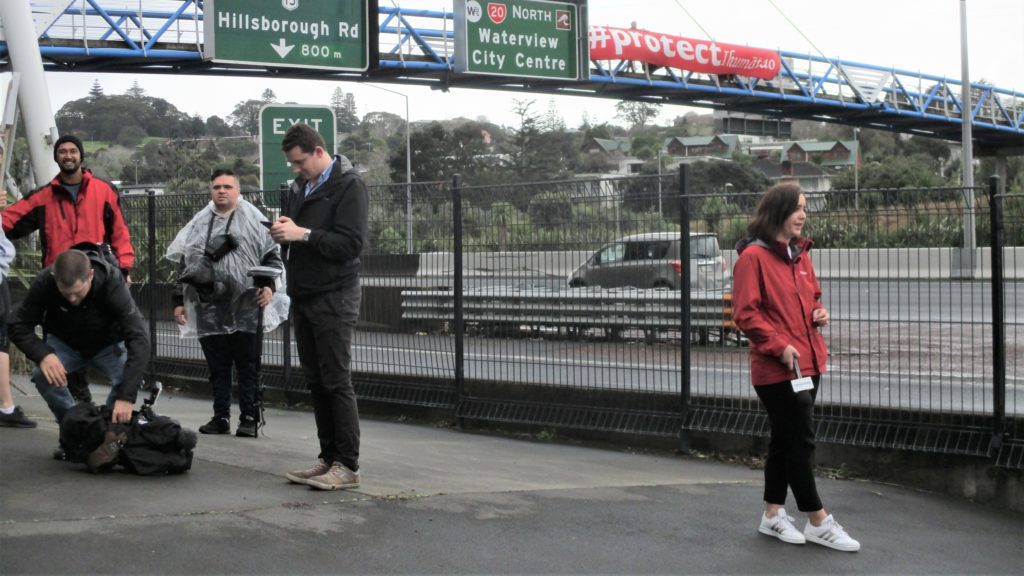
During first two weeks after the July 23 eviction, thousands more made visits to the Ihumātao frontline while the front paddock filled with tents numerous Māori with high public profiles such as Joe Hawke who led the 506-day Bastion Point occupation in 1977-1978, indigenous rights lawyers Annette Sykes and Moana Jackson, and Māori King Tuheitia with a contingent of 800 Waikato-Tainui supporters.
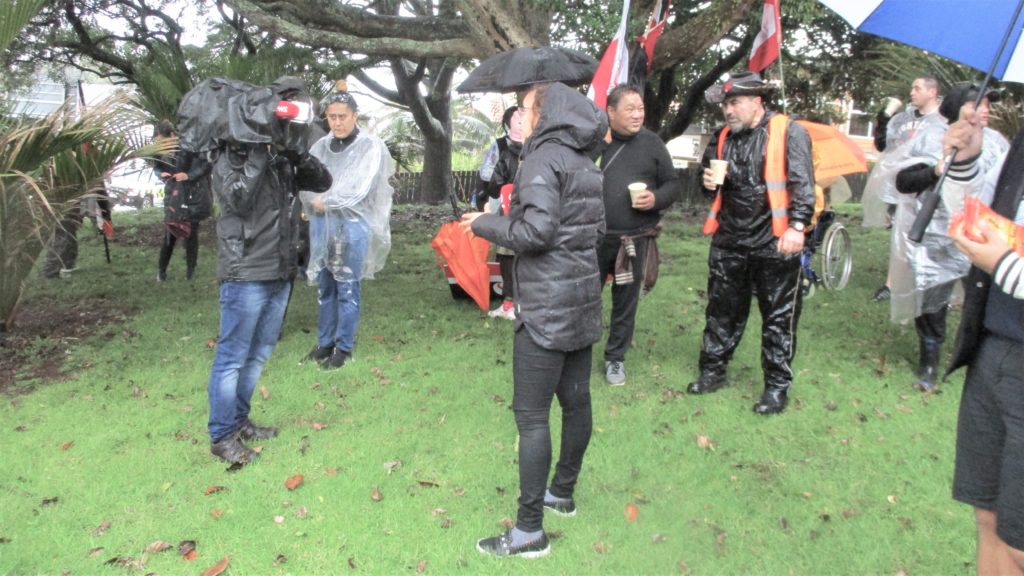
The New Zealand Prime Minister’s spin shifted to saying a solution would be at the table with the Kiingitangi. King Tuheitia stated that Māori had waited 150 years for this moment to arrive, so perhaps the Prime Minister was doing her research to see if there was a Ngāpuhi or Tainui prophecy she had missed in school, because according to Duncan Garner, the morning after the hikoi, her Māori Ministers had worked in the background to broker a deal for Tainui iwi to buy the land off Fletcher Building.

On the Government Paycheck: Former Cabinet Minister, Chris Finlayson, stated that Pania Newton should hikoi to Tainui because the tribe has links to Ihumātao and were the proper party to buy back the land, while neglecting to mention he receives an annual Crown stipend of $410,000 for once being a cabinet minister.
But by lunchtime, Garner’s breaking news scoop appeared to have burst like an over-inflated party balloon at a National Party election night party. Garner’s breaking news scoop followed the curious reappearance of former Treaty Negotiations Minister Chris Finlayson’s in the studio – the morning of the hikoi – listening on headphones to Garner’s interview with Pania Newton. On the AM Show, Finlayson suggested that Tainui iwi buy the land for a Novotel Hotel with an 18-hole golf course. Finlayson inoculated his politely racist dog-whistling saying, “[Tainui] could think about an appropriate development there that takes into account all the concerns Pania has mentioned.”

Inoculation is a public relations tactic used to acknowledge the inherent weakness of a manipulative argument, with the idea of quickly moving on . It relies on news media complicity, fast news cycles, as well as reporters lacking bravery to call-out such subtle jabs from quick pricks that do their work while appearing to cause little pain. The former Treaty Negotiations Minister said Tainui has lots of money. Chris Finlayson’s appeared two days earlier on Māori Television stating that private land buy-backs by the Crown should remain off the table. Dr Margaret Mutu explained the Crown stipulated a ‘treaty settlements’ process in the early 1990s that was designed to circumvent Māori attempts in the 1980s to counter the corporate takeover of New Zealand state assets – many of which became owned by transnational interests.
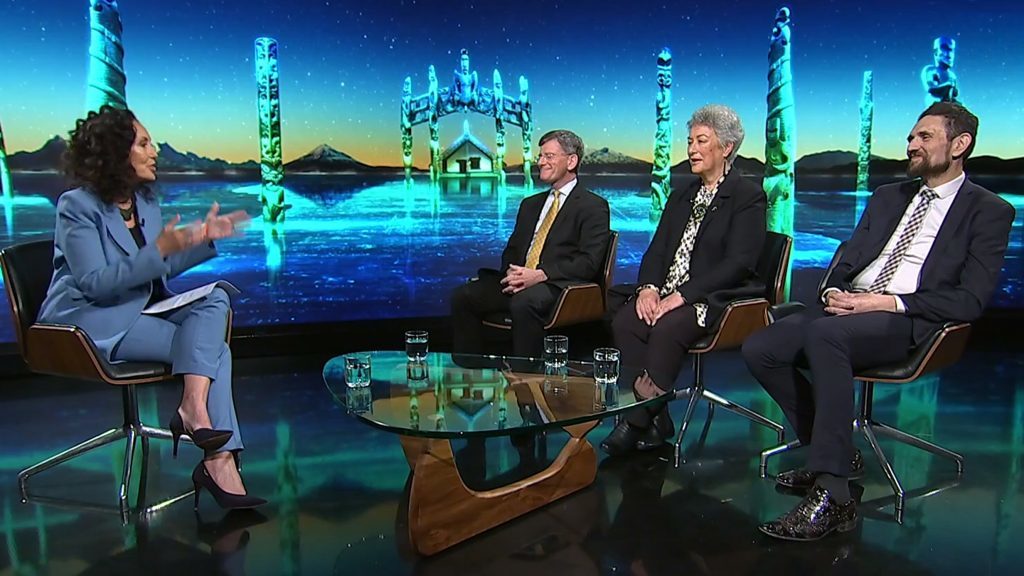
Finlayson’s role as a Minister of Treaty-Settlements-Past is fascinating. As Naomi Klein noted in her 2007 book, The Shock Doctrine, there’s a pattern around the world she noticed. Former officials of crises-past often appear at moments when new crises emerge to attempt to take control of the narrative. Therefore, Finlayson’s presence was a codified communication that signalled that the Ihumātao issue has the potential to snowball into a fully fledged crisis. The appearance of this former official from a crises-past shows that the Pākehā-dominated Rich-Lister ruling class of New Zealand are worried about the Ihumātao issue re-opening claims that Ministers such as himself have been happy to call ‘full and final’ – knowing they were paltry and unfair settlements in comparison to the value of territories, economic exclusion and treasures lost. Moreover, former Officials of Crises-Past can make misleading remarks where current officials could injure the Crown for the inherent deceptions in manipulating public opinion.

Meanwhile, Ardern has repeatedly excused herself from visiting Ihumātao, saying the dispute was not about her, and that the issue would be resolved with the Kiingitanga, mana whenua and Fletcher Building. But, Prime Minister Ardern has remained fixed, saying she would not rule out going to Ihumātao at some stage. When pressed, NZ’s PM has also said, “it’s a matter of timing”, “We will be there” and “it’s not about me”.
In the interviews associated with the image collage below, the country’s top lawmaker’s framing shifted daily in the week of the July 23 squatters notice, with new solutions offered to the problem. NZ’s PM started out saying the solution was to be found in the hands of Council and other parties involved on MaiFM, July 24 2019. The communications graduate said the solution was to be found by mana whenua to every news outlet, repeatedly. Then, this sneaky game of Hide-the-Problem-and-Seek-the-Solution shifted to saying that the solution was to found in iwi discussing the issue with mana whenua and council and the developer, and that such a process include the rangatahi, or young people, occupying the land. The PM’s messaging was clearly targetted at the brainwashed news audiences, and not for those familiar with the issue. The palpable paternalism in Jacinda Ardern’s statements were unwisely amplified with dog-whisting, when she also insulted SOUL’s campaign supporters, saying, “We just ask that they be respectful, that they look after the land that they will be visiting.”

In effect, the PM’s dog-whistling echoed Auckland Mayor Phil Goff’s dog-whistling tweet, when he typed “there be will be huis soon. In the meantime please respect each other and the land.” This means they are two peas from the paternalistic pod, because it was the Auckland Council and the Crown whom approved the residential development project with fast-tracked Special Housing Area designation that would make bulldozers scraping the historically significant land inevitable – without an ahi kaa grassroots kiataki whenua warrior intervention. Especially, since Goff and Ardern both parked SOUL’s petition in a virtual Bureaucratic Avenue, with the Ancestral Whenua-Space Meter running to see if a number of signees could catch up with the hundreds of millions of dollars in profits that Monopoly Board company, Fletcher Building, would have to forgo on their way to jail – if Aotearoa/New Zealand found out the transnational construction cartels’ development project entirely depended on collusion with Council, the Courts and the Crown – as this exposé lays bare.
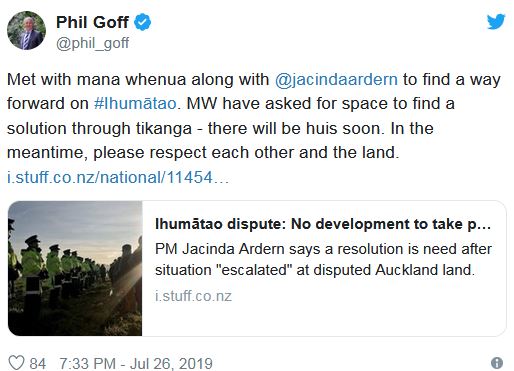
Especially, since Goff and Ardern both parked SOUL’s petition in a virtual Bureaucratic Avenue, with the Ancestral Whenua-Space Meter running to see if a number of signees could catch up with the hundreds of millions of dollars in profits that Monopoly Board company, Fletcher Building, would have to forgo on their way to jail – if Aotearoa/New Zealand found out the transnational construction cartels’ development project entirely depended on collusion with Council, the Courts and the Crown – as this exposé lays bare.
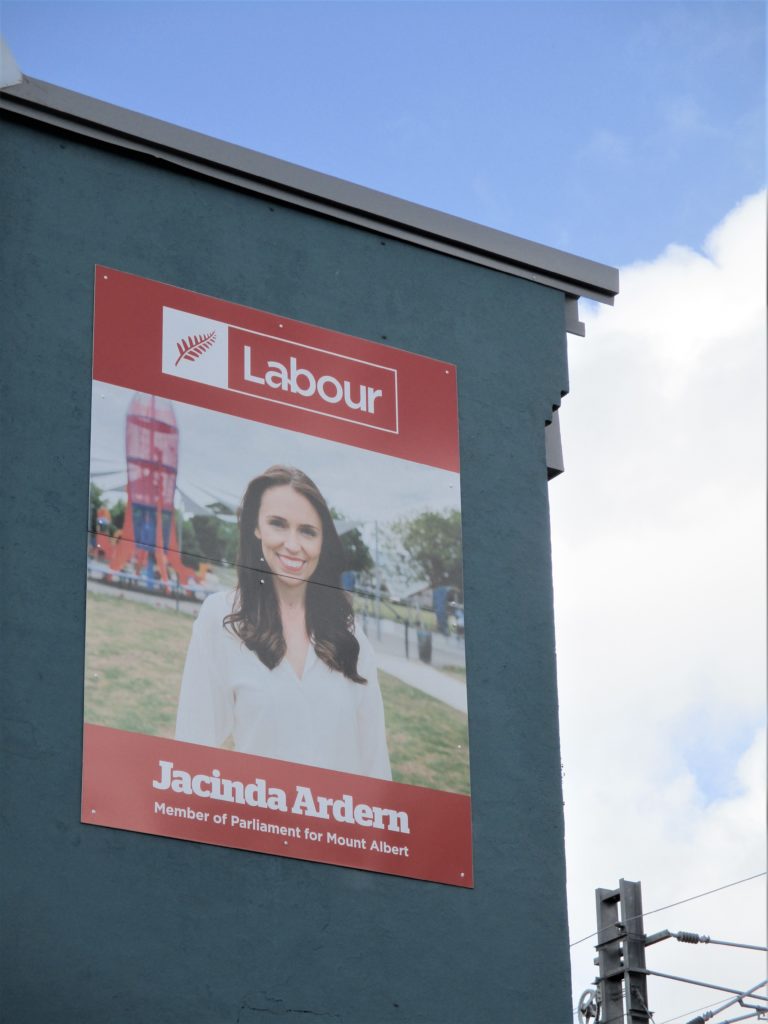
If Tainui are in negotiations with Fletcher Building to buy the Oruarangi land at Ihumātao – with the Minister for Māori Development and Local Government, Nanaia Mahuta, acting as private purchase broker – this would let the Crown and the Auckland City Council off the hook.
Precedents for Private Land Buy-Backs by Council & Crown
There are examples of both the Waitakere Council and the Crown purchasing lands off private owners. Two cases cited here, however, show they are fraught with machinations.
In 2009, the Waitakare Council bought a 2.7 hectare site at Te Henga/Bethells Beach for ‘community development purposes’ with the intention that the property would be leased to Te Kawerau ā Maki so that the iwi could build a marae in their ancestral stronghold. The iwi held firm to their perference not to lease the land, which the Waitakere Council bought for $935,000, and this land was supposed to be transferred to Te Kawerau ā Maki in mid-June 2018 after a vote by the Auckland Council’s finance and performance committee to gift Te Kawerau ā Maki the land at 240a Bethells Rd, Te Henga, to build a marae and papakāinga housing.
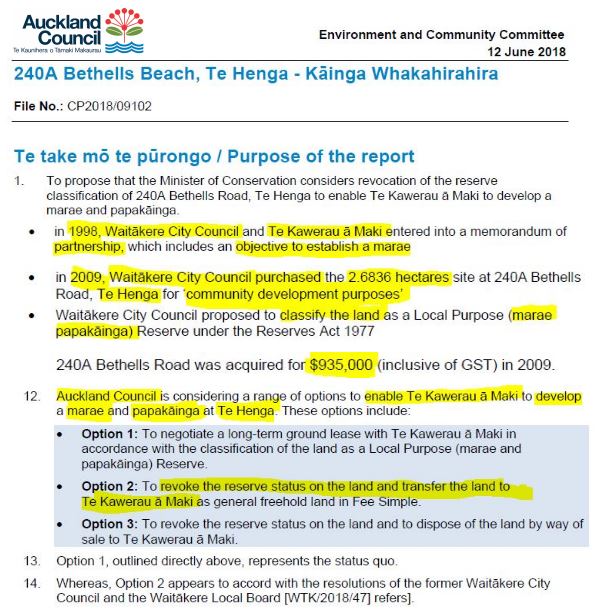
Council Purchase: This Environment and Community Committee report traces the 2009 purchase of 2.7 hectares at Te Henga/Bethells Beach by the Waitakere City Council off private land owners so that the landless iwi, Te Kawerau ā Maki, could build a marae.
However, the Auckland Council held out, as the Henderson-Massey Local Board minutes of March 2019, shows that a bargain was struck with Te Kawerau ā Maki to relinquish its interests in the precinct property on Henderson Valley Road property, before the Council would transfer the title of the Te Henga property. The delays stink of coercion by the Auckland Council, especially since Te Kawerau ā Maki had been formally seeking a marae site since 1998.
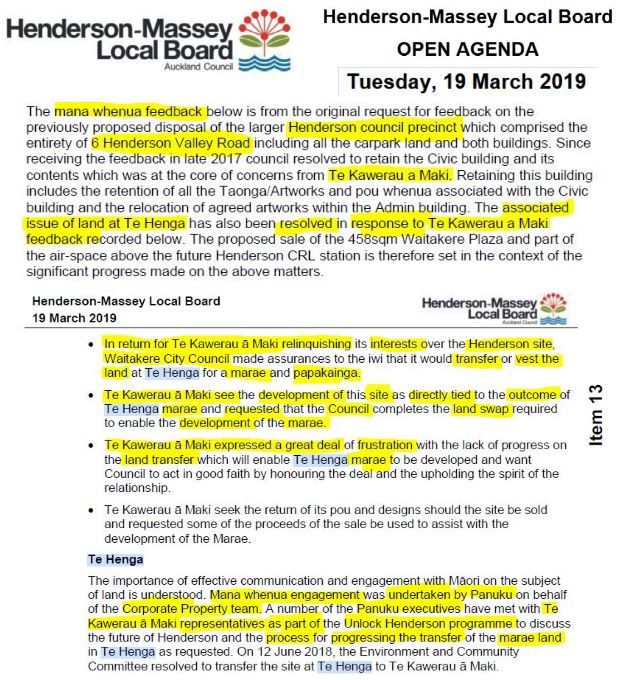
Pound of Native Flesh: This Henderson-Massey Local Board report shows that the Auckland Council withheld transferring the title of the 2.7 ha Te Henga/Bethells Beach property until Te Kawerau ā Maki withdrew its claim to the Council precinct on Henderson Valley Rd.
Another example of a land buy-back occurred on behalf of iwi Te Roroa, who sought the return of urupa, burial caves and other waihi tapu sites on farmed lands at the Maunganui Bluff, Aranga, north-west of Dargaville. Te Roroa iwi had claimed 38ha of the 688 hectare property, bought by farmer Alan Titford in 1986 for $600,000, after it was found a Manu whetai Reserve, at the centre of the dispute, had been included in the farm land title. In 1992, the Waitangi Tribunal recommended that the Aranga farm be returned the Te Roroa iwi. In 1995, the Crown paid $3.25 million – after a bitter dispute – and after Titford’s house was razed to the ground in 1992 and not before the farmer bulldozed a preserved pa. The arson helped inflame anti-Māori sentiment across the country, Pākehā resentment about Treaty claims and emboldened lobbying to take private lands in Treaty Settlements off the table. In 2013, when Titford was convicted of arson – among other crimes – Judge Duncan Harvey said “it [was] time for the people of New Zealand to learn the truth” because his devious and malicious actions were designed to turned the public against Māori and garner sympathy for himself so that he would get higher compensation from the Crown for his farm. This mission for sympathy was helped along when Titford rang local National Party MP Ross Meurant, whose first thought was to ring The New Zealand Herald, which is strange because most people would call the Fire Department and Police. Meurant’s role could qualify for entry into a spooky file, since he was formerly second in command of the Red Escort Group, or Red Squad, during the 1981 Springbok Tour, back when the Muldoon was in power and the South African Apartheid Regime was controlled by the Afrikaner Broederbond, a white supremacist brotherhood modelled on British Freemasonry.
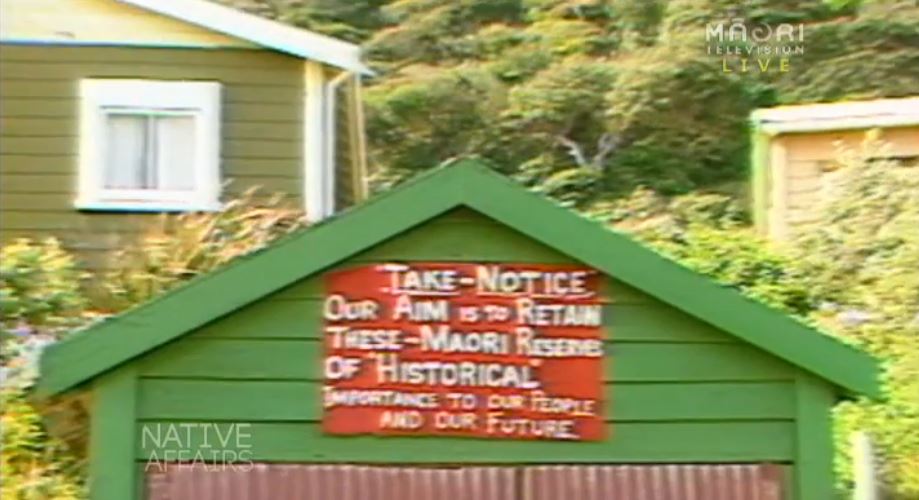
As The Spinoff recently reported, Titford’s racist campaign – which included the arson – “the National government relented and changed the legislation to exclude the return of private land to iwi.” Indeed, in 2011, Te Roroa were still seeking the return of 2000 hectares of ancestral lands, which included wahi tapu burial lands, Kaharau and Te Taraire, at Waimamaku and seeking more cash from the Crown because Māori face the hurdle of paying market rates to purchase private lands. On 23 October 2011, before the Parliament’s Māori Affairs Select Committee hearing on Rev. Daniel Ambler refuted the position that Te Roroa should pay for burial grounds confiscated by the Crown. Speaking to Dave Hereora (chairman), Georgina te Heuheu, Pita Sharples, Pita Paraone, Chris Finlayson, Tau Henare, Mita Ririnui and Charles Chauvel. Rev Ambler said it was a mockery and cultural insult. “We never sold Kaharau. The caves were raped of everything in them and now they want us to buy those places back.”
These two examples show how tricky, drawn out and rare it can be for Māori to get the Crown or Council to stump up for privately-owned land.
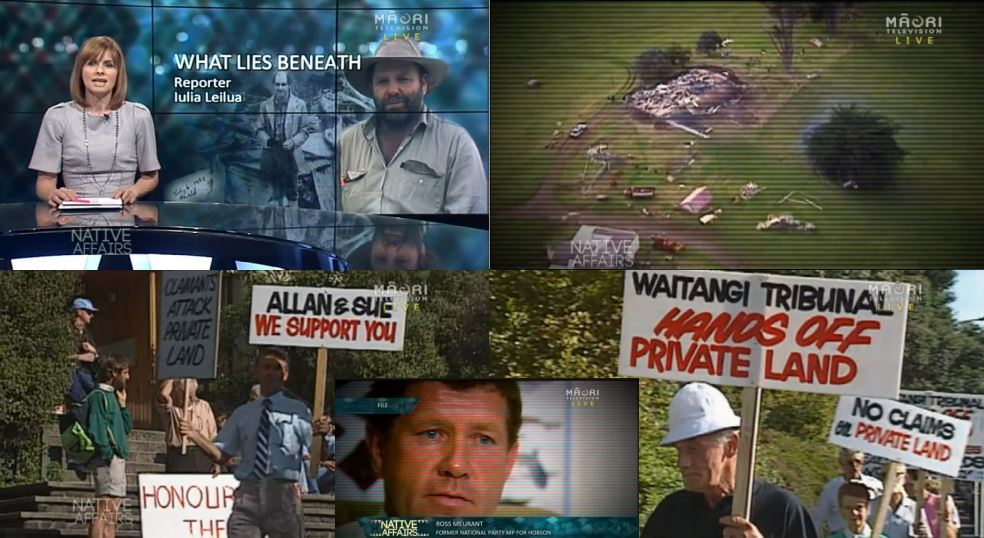
The Prime Minister’s excuses deflect from full disclosure that scholars such as Margaret Mutu, Moana Jackson and Annette Sykes, whom could supply to New Zealand in a simulcast live debate with the Prime Minister, the current Treaty Negotiations Minister and the Minister of Arts, Culture and Heritage on Maori TV, TVNZ, TV3 and Sky like New Zealand did for Rugby World Cup when Māori Television beat other networks to the negotiating table.
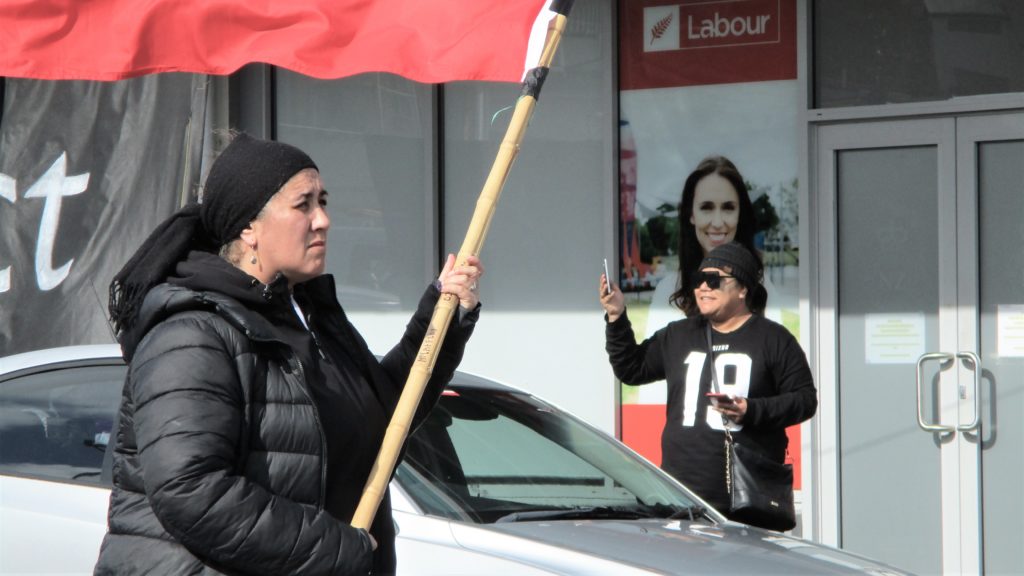
On 20 August 2019, outside the Māori King’s base at Tūrangawaewae Marae, in Ngaruawahia, Jacinda Ardern told the news media that the solution has to be at a table with Kingitanga. Prime Minister Arden said:
“I know we will continue to have leadership by Kiingitanga as we have always had and you can guarantee that we will work there alongside, that we will bind together, that we will hold fast, that we will hold firm.”
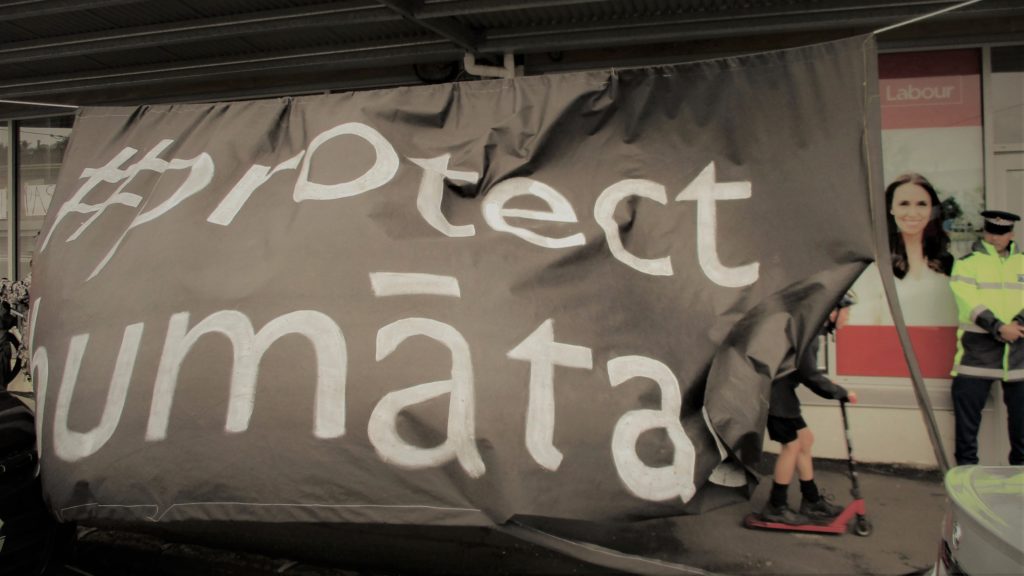
When New Zealand’s prime minister says New Zealand has always had leadership by the Kingiitanga, she is blatantly suppressing history in an ongoing fraudulent attempt to keep that large cohort of brainwashed New Zealanders in a deceptive holding pattern.
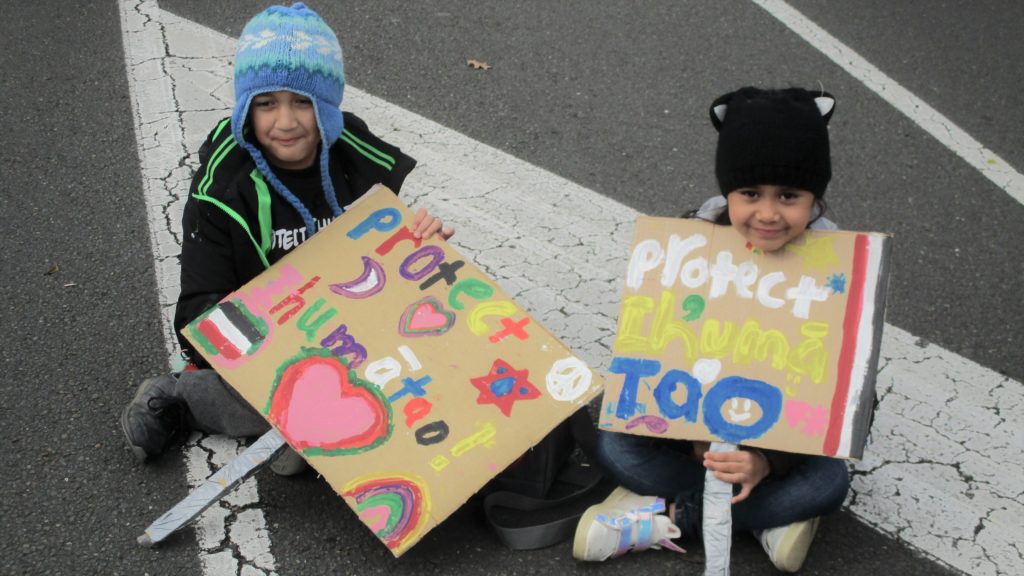
This sleight of hand is not unlike a farmer with his flock who withholds the dark truth of an eventual slaughter by keeping the scenes of mass murder distant.
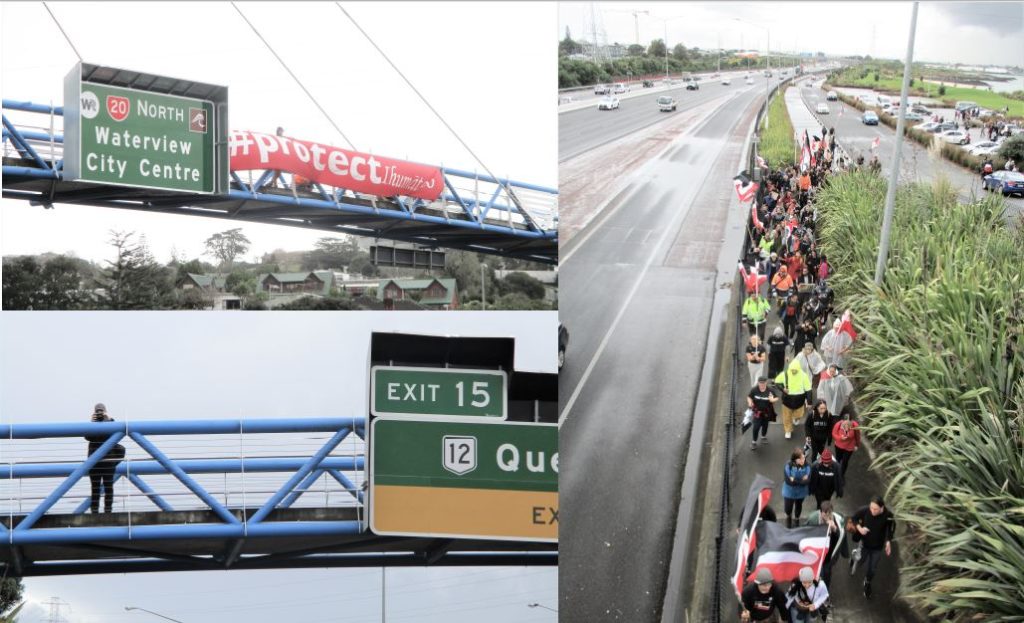
If the Crown had always tolerated, accommodated or supported leadership with the Kiingitanga – then how does one explain Freemason Governor Bro. George Grey’s eviction notice of July 9th 1863 – which resulted in the 1865 confiscation of the 1100 acre Ihumātao block by Colonial Crown Executive Orders in Council?
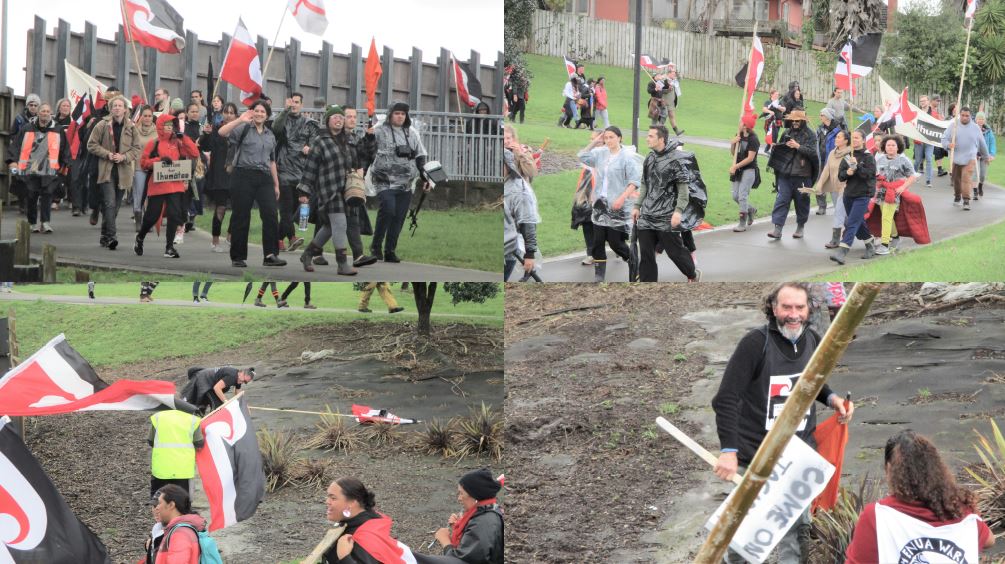
How does Jacinda Ardern explain any material shift between 1863 – when mana whenua were cast as insurrectionist Natives in rebellion and 2019 when mana whenua were cast as “squatters”?
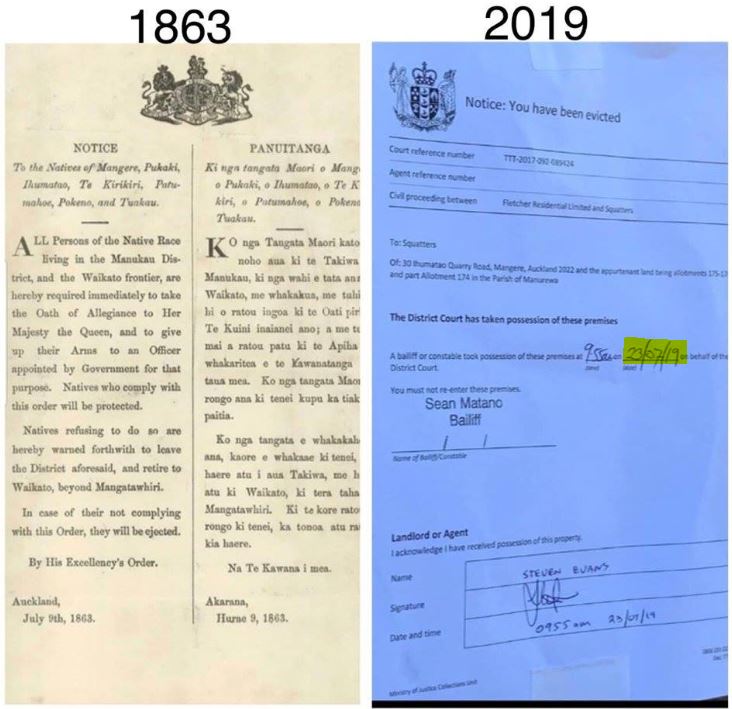
Intelligence, Mettle & the Battle to Control the Narrative in 3 Acts
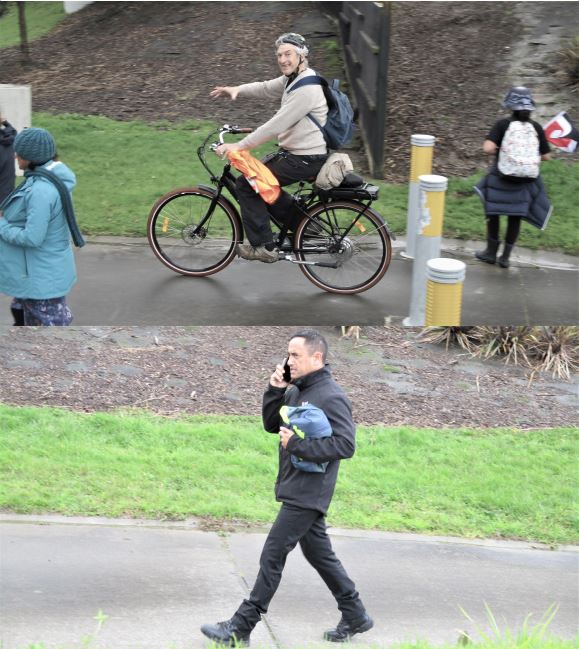
The day prior to the her Tūrangawaewae Marae visit at Ngaruawahia, New Zealand’s top lawmaker back-peddled when she told the parliamentary press gallery that ultimately the resolution needs to come from mana whenua.
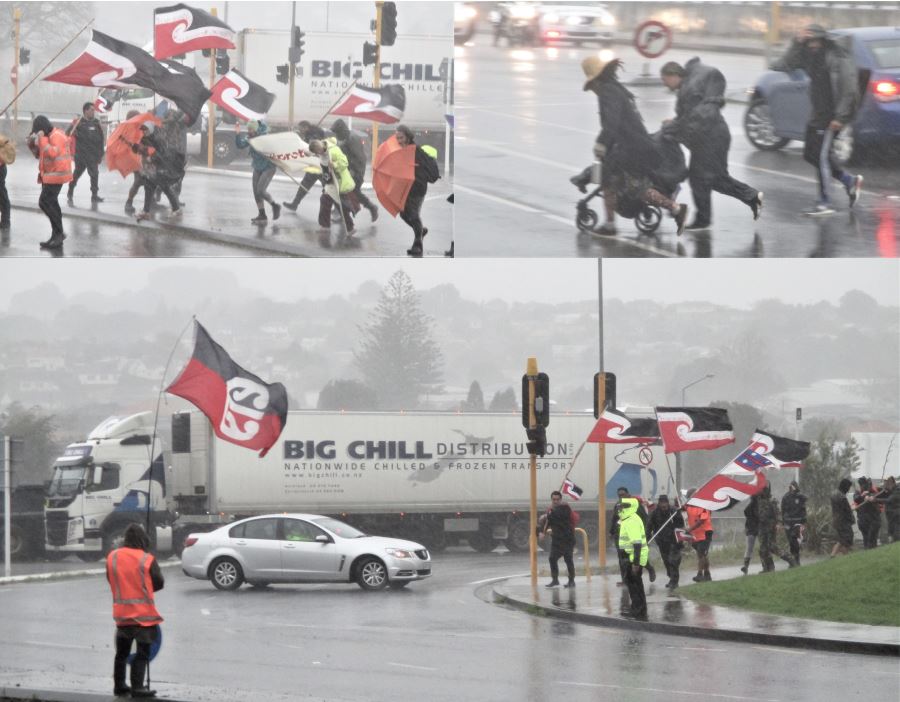
The sleight of hand occurring here belies a politer form of institutional racism than the kind that existed during Prime Minister Robert Muldoon’s tenure as prime minister when 222 people were arrested by Police to end a 506-day occupation at Bastion Point in 1978.
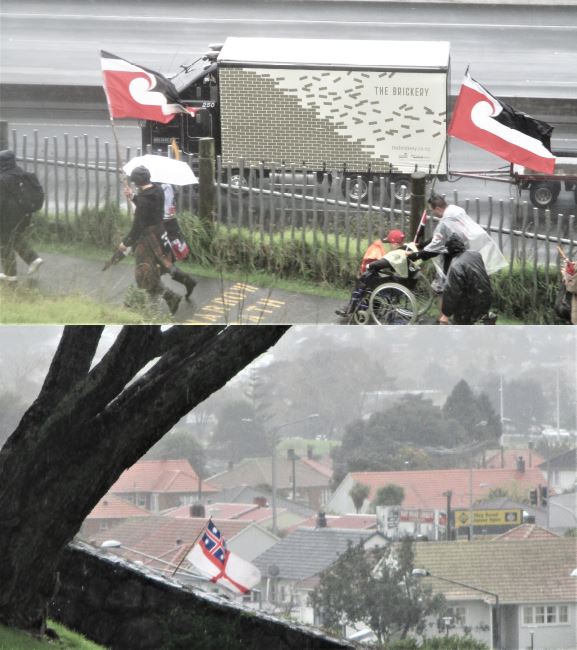
The Ardern Coalition Government is framing the dispute as an issue that can only be resolved within Māori. Packaged within this staged stance is the false claim that it is simply a rift between rangatahi, or youth, and their elders, or kaumatua.
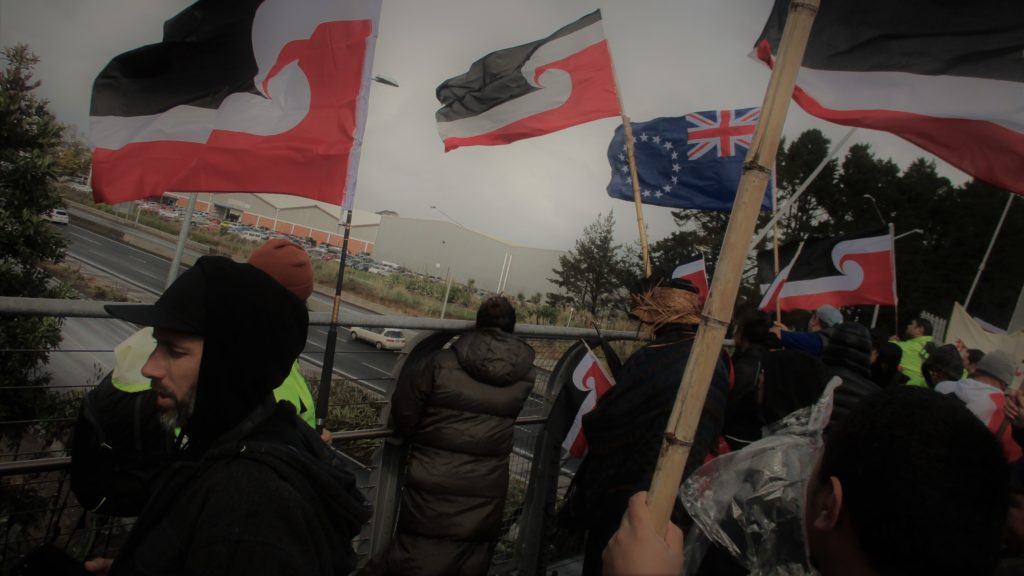
This ‘news framing’ – that the solution has to be found within Māori – is slyly paternalistic. Because it is designed to appear to the brainwashed New Zealand Tax Herds that the dispute is really just an argument that ‘the Maoris’ need to sought out among themselves.
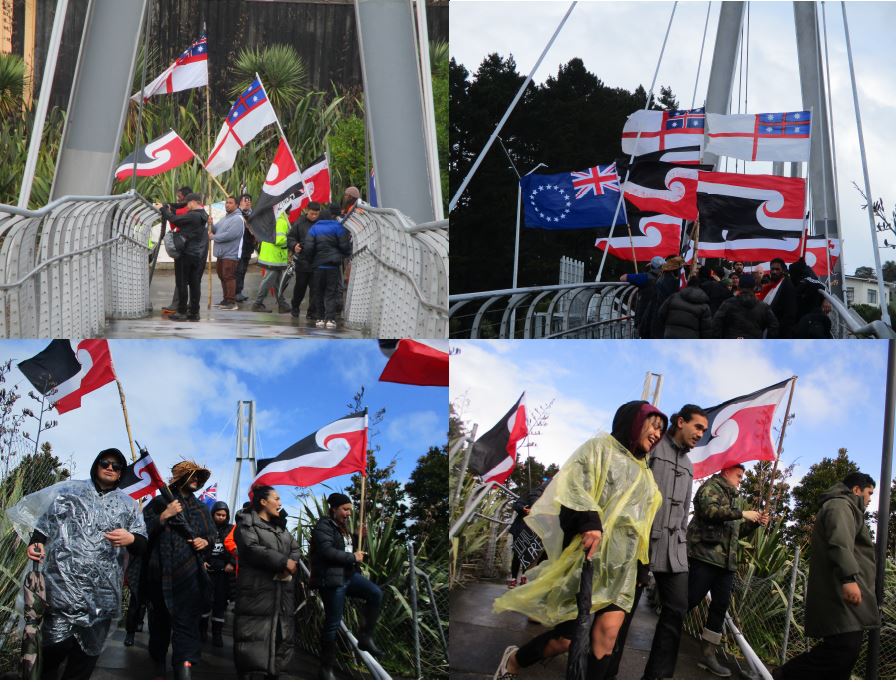
The Soul campaign to protect Ihumātao has created an exquisitely simmering crisis for the Neo-Colonial Crown. Because the Neo-Colonial Crown, the Councils and the Courts do not follow the Rule of Law Doctrine – which would otherwise require such entities to follow robust processes to ensure that Māori ancestral claims to land were not run roughshod over – New Zealand’s Pākehā-dominated ruling class are trying to avoid this issue snowballing into the full-blown crisis.

To forestall the Ihumātao issue redrawing the political landscape whereby the New Zealand Government are forced to acknowledge that sovereignty over New Zealand was not gained by the 1840 Waitangi Treaty, but rather through a war of conquest from 1860-72, along with rampant land-swindling and stealthy legislative moves – the Ardern Coalition Government are trying to retake control of the narrative.
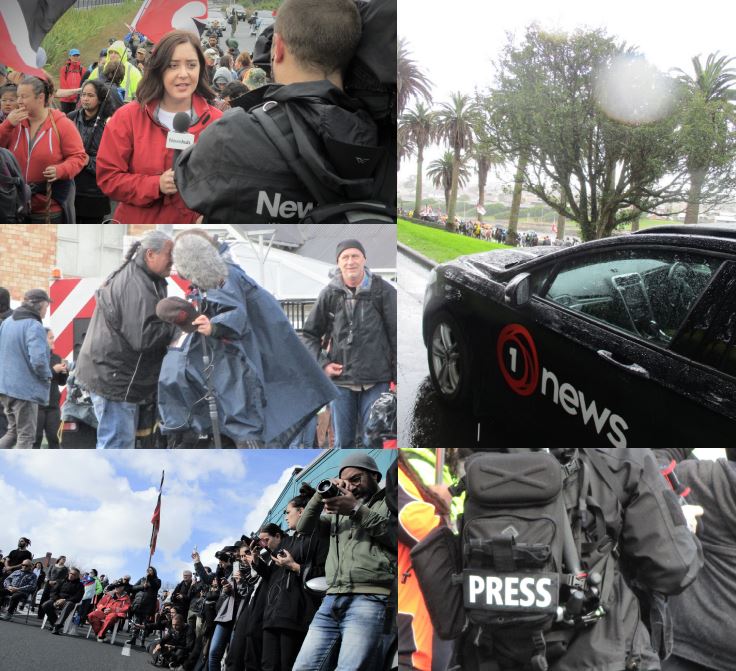
Indeed, who controls the narrative in this battle wins the broader war over whether sovereignty remains in the super-wealthy hands of Pākehā-dominated national and transnational interests – including the Queen of New Zealand – or if it shifts to include self-determining communities.
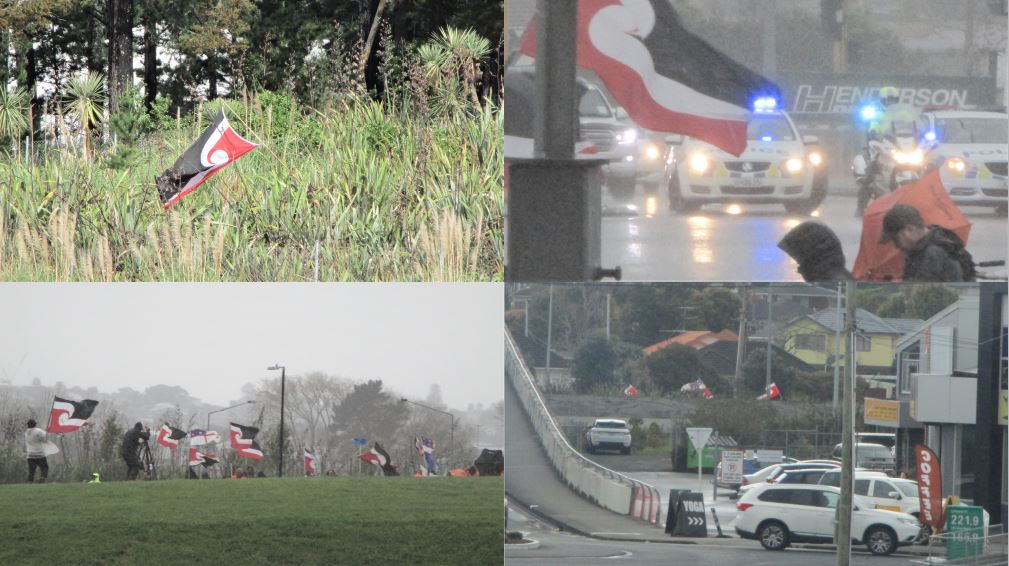
The Ihumātao dispute really is over world-views between those who always believe solutions to Māori land loss should not overly burden the dominant Pākehā-imposed paradigm of Neo-Colonial transnational capitalism and those who believe that there needs to be spaces created where title to land is returned to mana whenua.
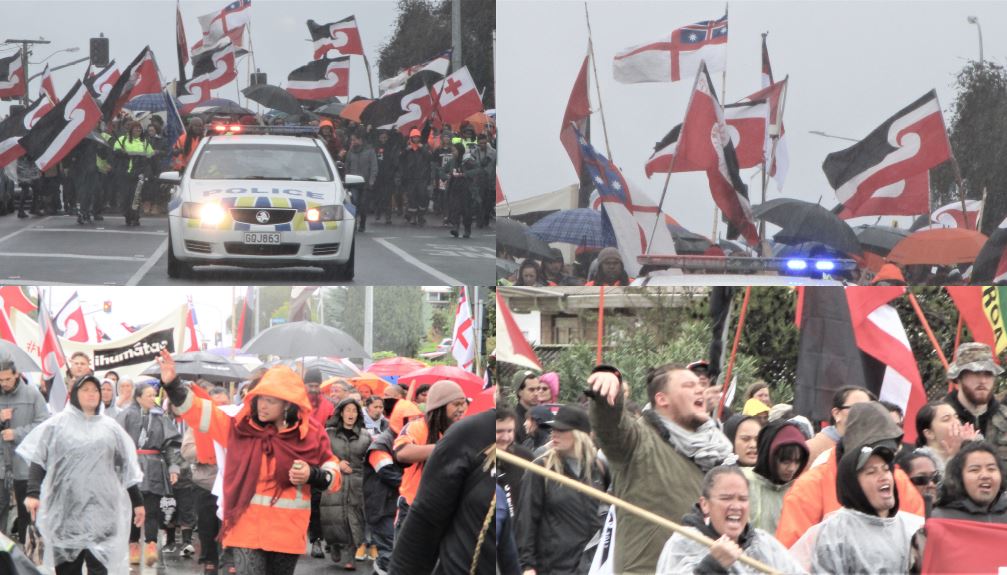
This kaitiaki worldview questions why whenua should have to return a profit in a corporatized model the Crown has essentially structurally imposed on iwi and hapū, by returning little land with blood money settlements that at most are only 2% value of what was lost in land, economic returns and stolen treasure. This kaitiaki paradigm also believes that the Crown, the Council and other party’s implicated in the confiscations, land swindling and other stealthy moves that resulted in Māori land loss – should stump up the expense to buy the land off private owners.
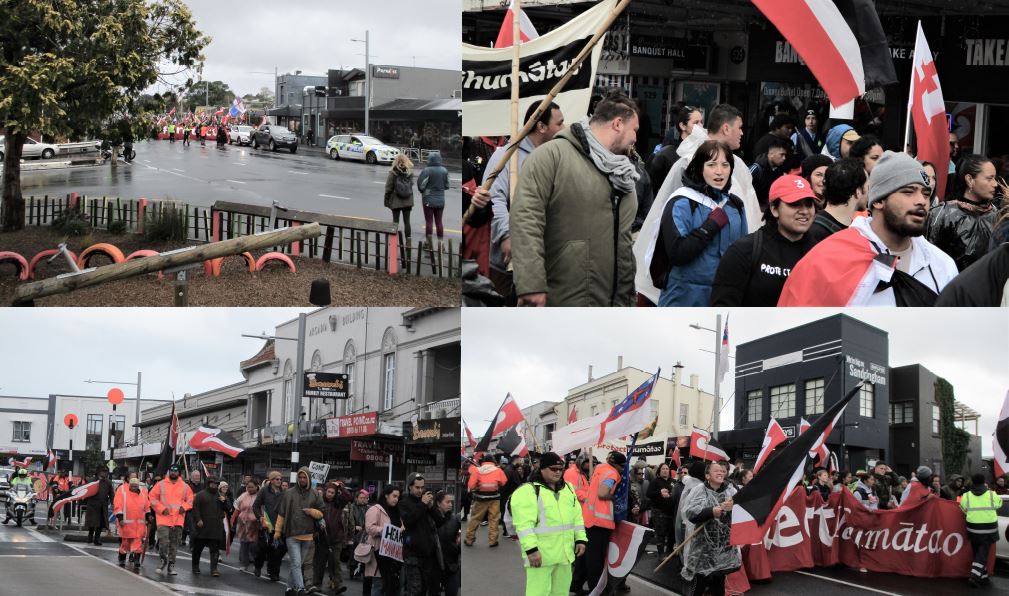
The media – including the Māori media – are letting New Zealand’s top lawmaker off the hook because Prime Minister Ardern avoids fessing up to New Zealanders that the Crown doesn’t follow the Rule of Law Doctrine. If the Crown, Councils and Courts observed the rule of law – weighing all evidence, facts and arguments, then Māori claims to ancestral land could not be run roughshod over.
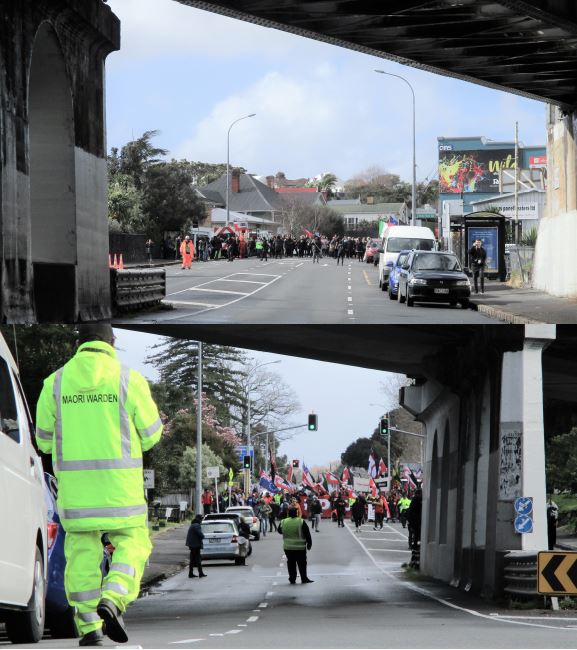
This case of the disputed 81-acre Oruarangi Block in the Mangere District shows that the Auckland Council, the Environment Court, the Māori Land Court, the Waitangi Tribunal, the Māori Affairs Select Committee, the High Court, the New Zealand Police Constabulary, and the Neo-Colonial Crown lack robust processes.
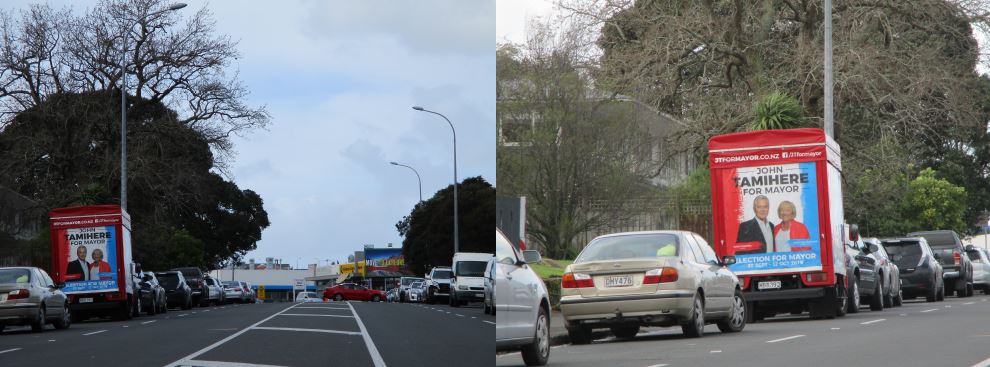
The fake paternalism-free posturing that underpins this official, unsustainable stance over Ihumātao also reflects the Crown’s broader avoidance to admit that the Waitangi Treaty chiefs did not cede sovereignty in 1840 – as the Waitangi Tribunal found in its October 2014 report.
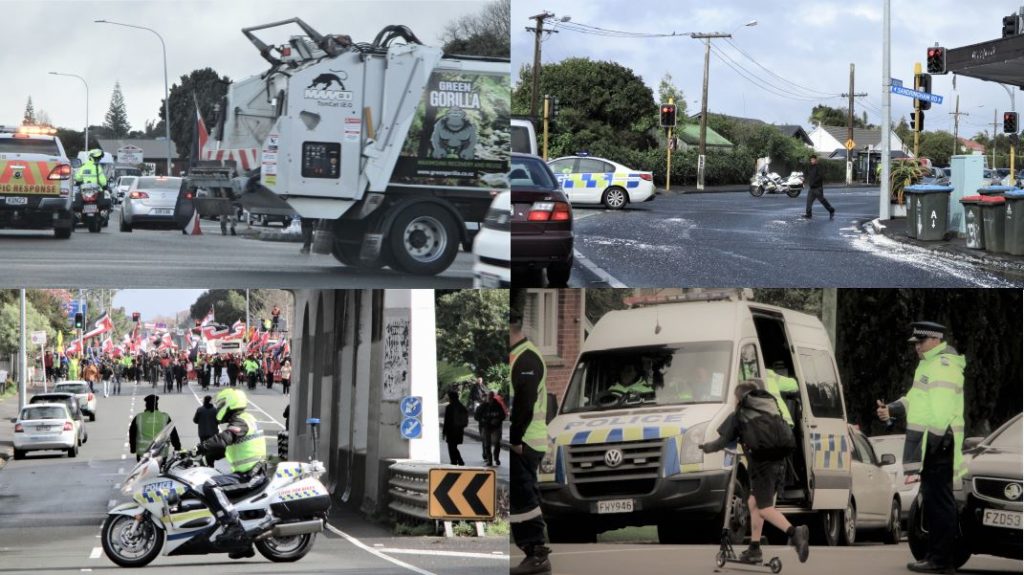
The Crown maintains the fraudulent position that Māori signed away sovereignty in 1840 because it does not want to admit that the British Crown and its Colonial Crown incarnation gained sovereignty by swindle, struggle and stealth – including waging the land wars of 1860-1872 to destroy the Māori communal economy.
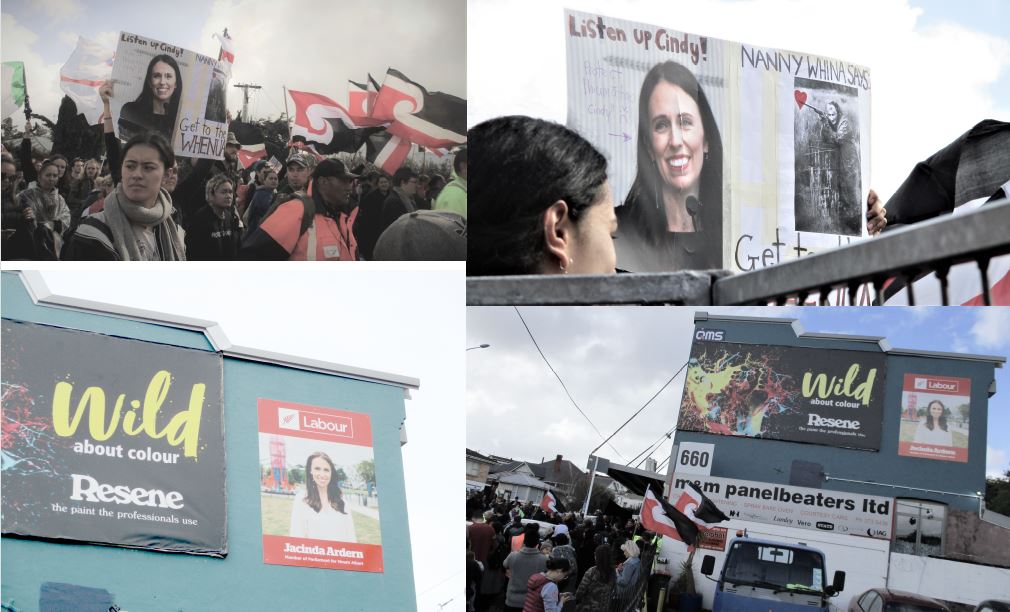
If the Crown were to admit those bigger facts loudly and clearly – it would have to admit that the British Crown did not gain paper sovereignty with the Treaty of Waitangi – since the real purpose of the Treaty Theatre was to neutralize opposition from chiefs by creating division among those chiefs that signed and didn’t sign.
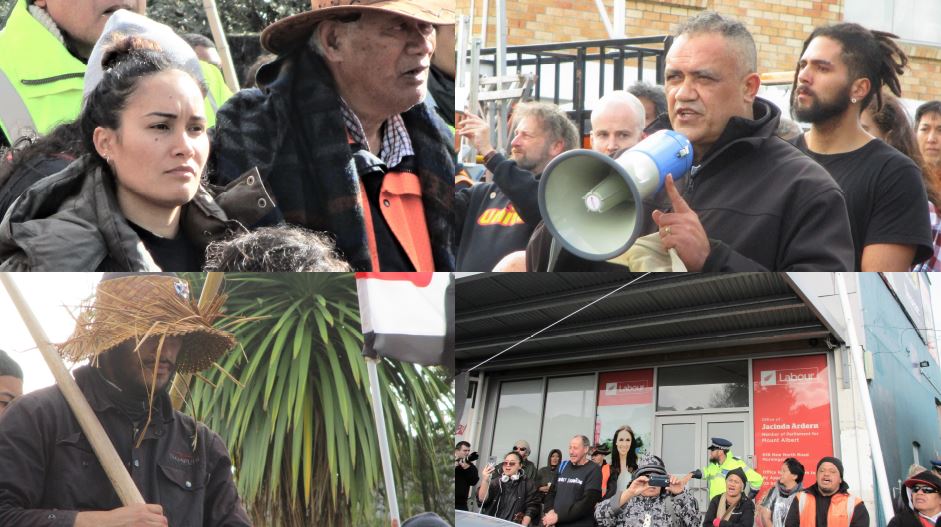
But rather, sovereignty on paper over New Zealand was gained through a series of legal moves starting with Queen Victoria’s Letters Patent of Extension of June 15th 1839 that extended the boundaries of New South Wales around New Zealand, followed by proclamations and legislation that were “pushed forward” in parallel to British Navy Captain Hobson’s activities. These moves were consistent with English Constitutional Law and were not merely legal actions taken should it have turned out that Captain Hobson failed to gain cession by treaty.
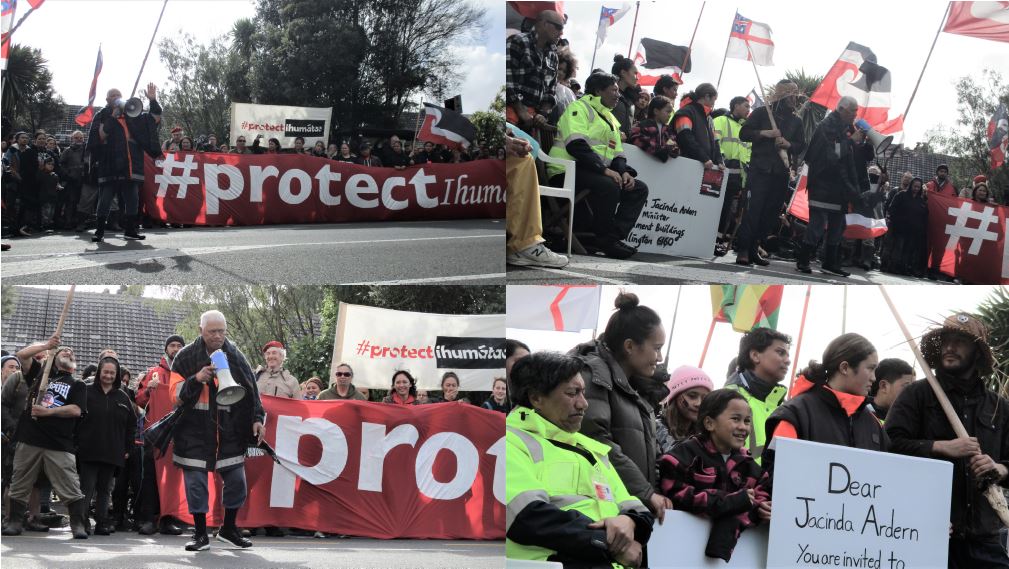
Because this 1840 Waitangi Treaty ruse was spun on a fulcrum of deliberate language translation differences, lying by omission and selling the alleged positive benefits – the inherent fraud was committed to buy time knowing that a war of conquest would ensue at a later date.
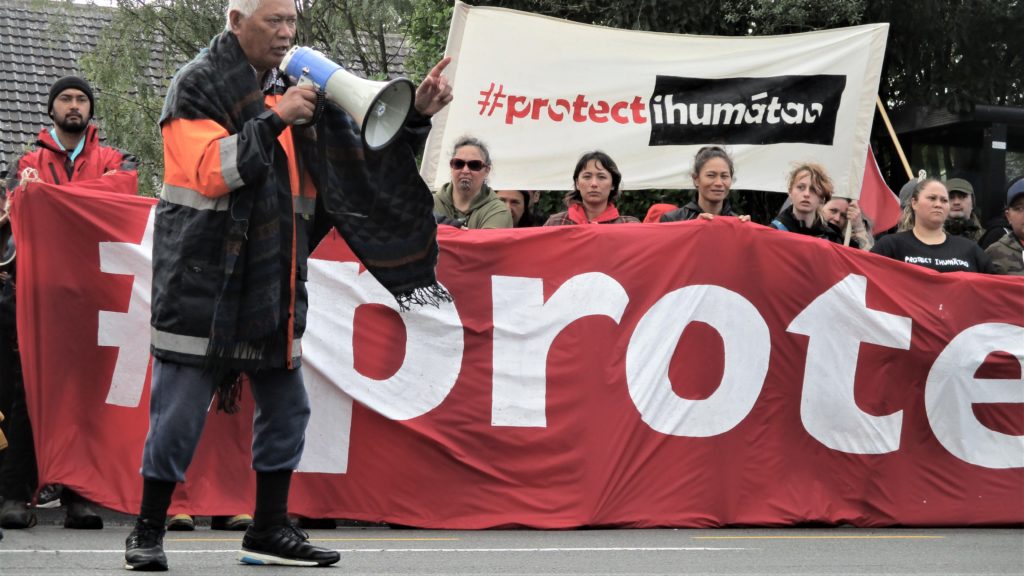
In other words, the British Crown was buying time because it lacked the spare military resources to impose substantive sovereignty by conquest, which would come later under the cover-story that ‘the Natives’ were in rebellion – since Māori were deemed to have ceded to Queen Victoria’s sovereign authority.
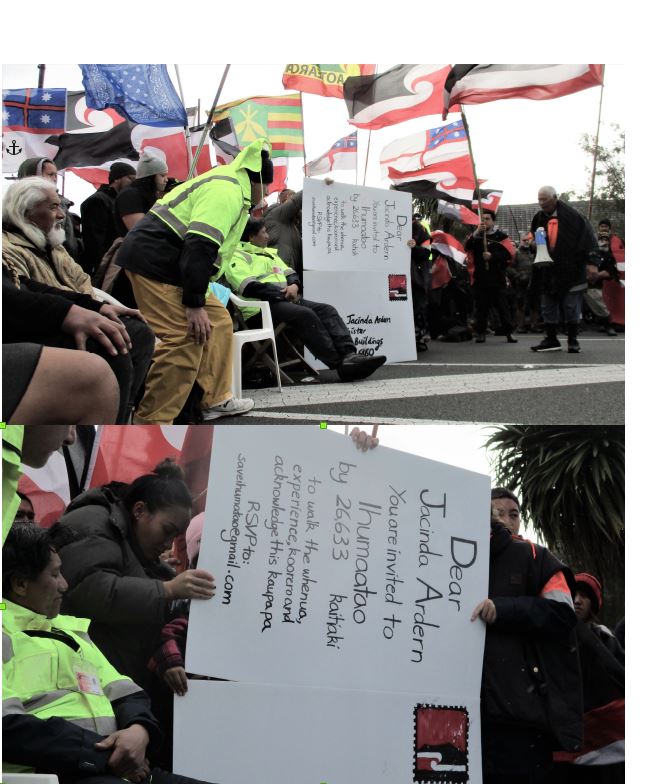
And because that war of conquest was largely how substantive sovereignty replaced paper sovereignty – the Neo-Colonial Crown of today is playing a delicate game where it pretends the English Treaty of Waitangi is valid.
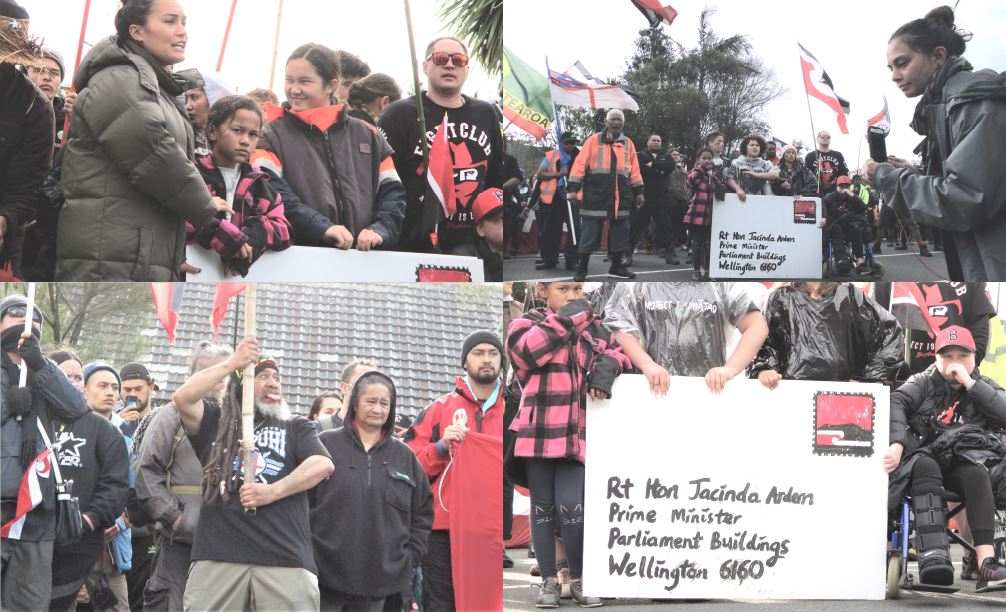
Therefore, because the Crown maintains the Waitangi Treaty is the foundational legal basis for its existence, it follows that the Crown does not follow the Rule of Law Doctrine, which would otherwise require the Crown to fully disclose the deception in the British moves to make the Treaty of Waitangi happen.
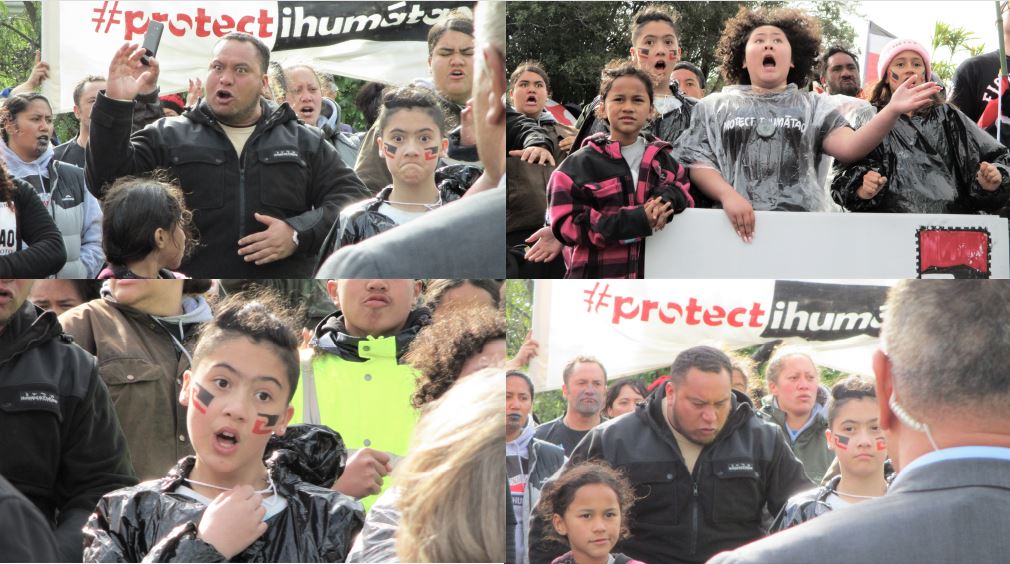
Since the NZ Neo-Colonial Crown continues to uphold the English version of the Treaty of Waitangi – which states that Queen Victoria and all of her heirs hold sovereignty over New Zealand forever – the Crown is breaching section 240 of the Crimes Act, which deals with crimes of deceit – as The Snoopman pointed out as a result of a two-year investigation published on conservative liberal website, The Daily Blog, on Waitangi Day 2018.
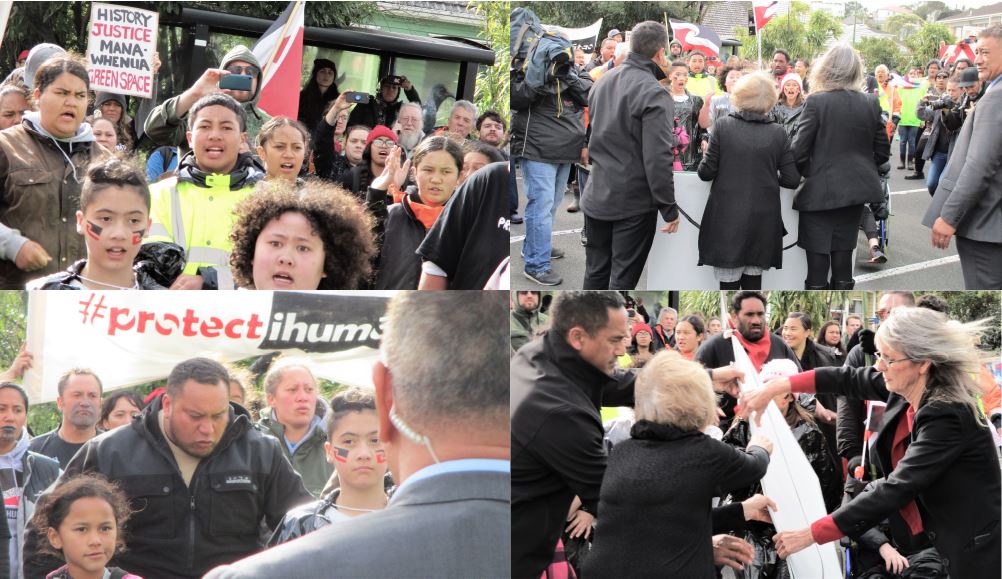
Sussing: A Māori girl checks out the man with the FBI-issue earpiece like the one that Newshub breakfast host Dunkie Garner wore when he interviewed Pania Newton – just before former Treaty Negotiations Minster Chris Finlayson was interviewed elsewhere in the MediaWorks callously suggesting that Tainui iwi buy the land for a Novotel Hotel with a 18-hole golf course.
If Māori – along with sympathetic Pākehā – were to challenge the Queen of New Zealand’s perceived right to sole sovereign status, table a constitution that sought to displace Her Majesty’s Authority, and call-out the NZ Crown’s failure to disclose the fraudulent game to treat with ‘the Natives’ in 1840 – the Crown would have to concede power half territorial, financial-economic and political power to Māori.
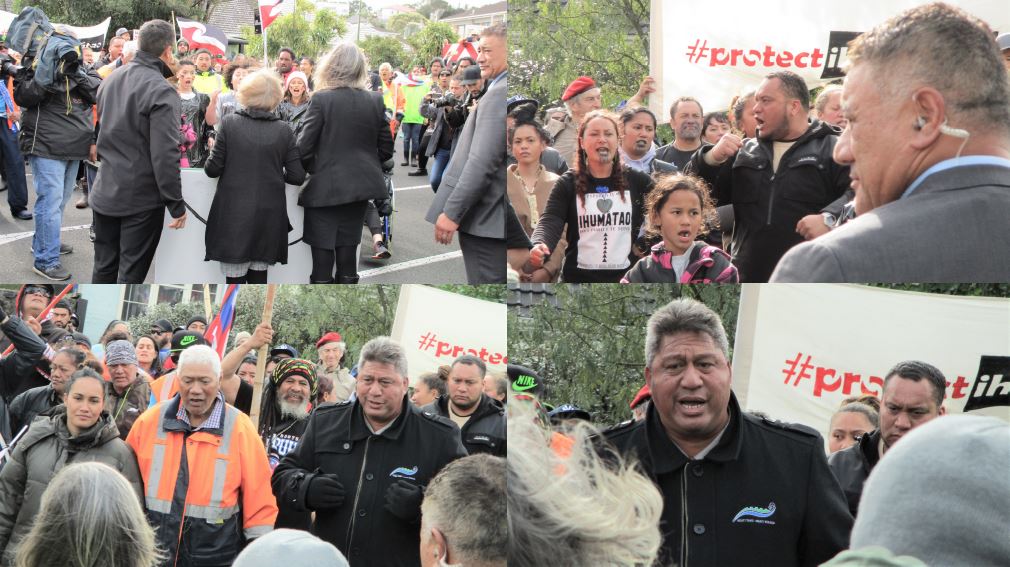
The contested land from which Māori were effectively evicted by Freemason Governor Bro. George Grey’s ultimatum, dated July 9th 1863, was conferred a solid title when this Commander-in-Chief’s signature was scrawled on a land grant, dated 28th December 28th 1867.
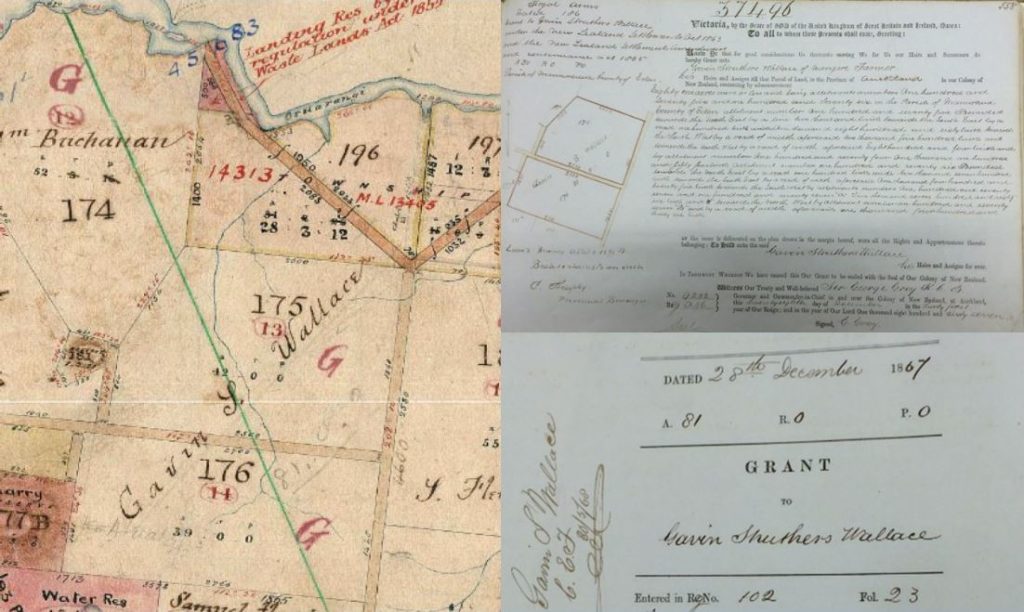
Freemason Bro. Grey could not have escalated the war without the pivotal role played by the Bank of New Zealand, which brokered a £3 million loan from the Imperial Government and supplied the Colonial Government with an overdraft that fluctuated between $500,000 and $800,000. The Premiere of New Zealand at the time of the Waikato War (1863-64) was Freemason Bro. Frederick Whitaker who made his law firm partner, Thomas Russell, the Minister of Colonial Defence. Together, they wrote several key pieces of law to legalize casting Māori as insurrectionist rebels, confiscating lands and raising credit to finance the escalation of what was really the New Zealand Masonic Revolutionary War of 1860-1872 – as The Snoopman has shown in his illustrated essay, The Masonic New Zealand Wars: Freemasonry as a Secret Mechanism of Imperial Conquest During the ‘Native Troubles’.
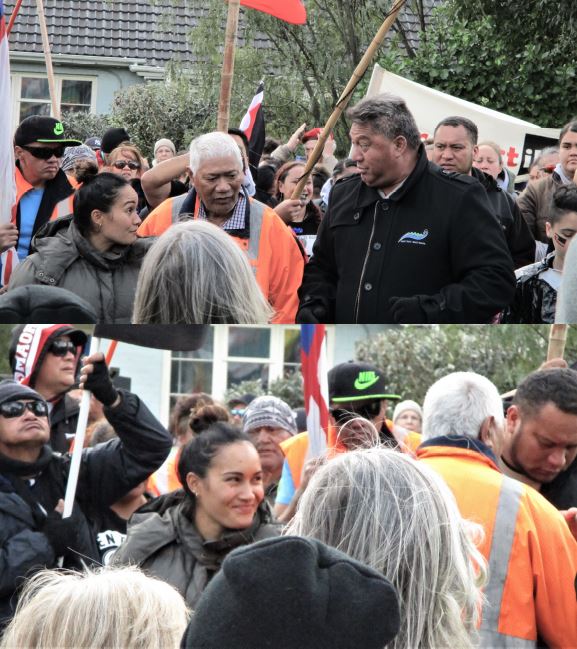
Today, the Neo-Feudal fee-simple title to the contested 81 acres is held by construction consortium Fletcher Building Limited, which is 54% owned by three transnational banks, HSBC, JMorgan Chase Bank and CitiBank.
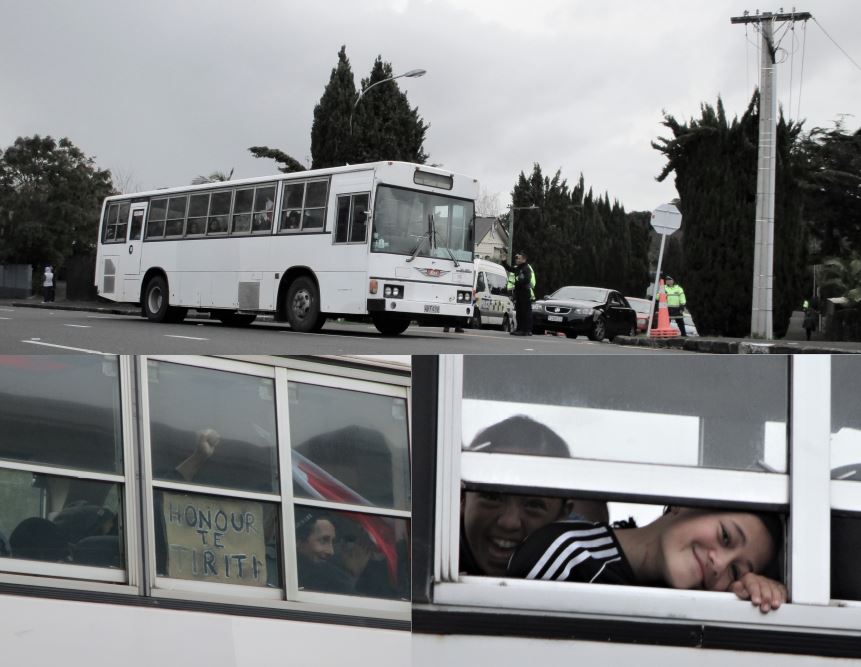
Instead, the Crown applies the law arbitrarily. This is why there are no robust processes that would have otherwise ensure the return of the 81 contested acres comprising the Oruarangi Block at Ihumātao – along with the adjacent Otuataua Stonefields Historic Reserve – which is owned by the paternalistic Auckland City Council.
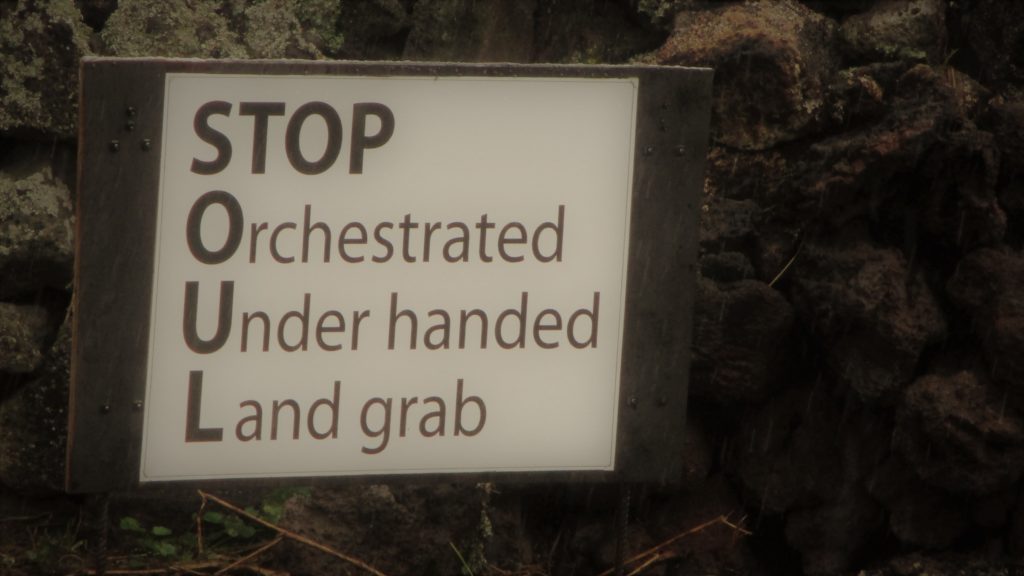
Colonial Legacy in Neo-Colonial Era
To sum-up, the Crown is passing the buck by appearing to be respectful of Kiingitanga authority to find a Māori solution – when in fact it is avoiding taking responsibility for the crimes of its Colonial-era incarnation.
The Crown gets help from some of the corporate media, with The New Zealand running front-page lead story about a 20-month old ferry injury saga. It relegated the biggest story in New Zealand of the week to the bottom of page three, with a brief report and a sympathetic opinion piece – on page eight.
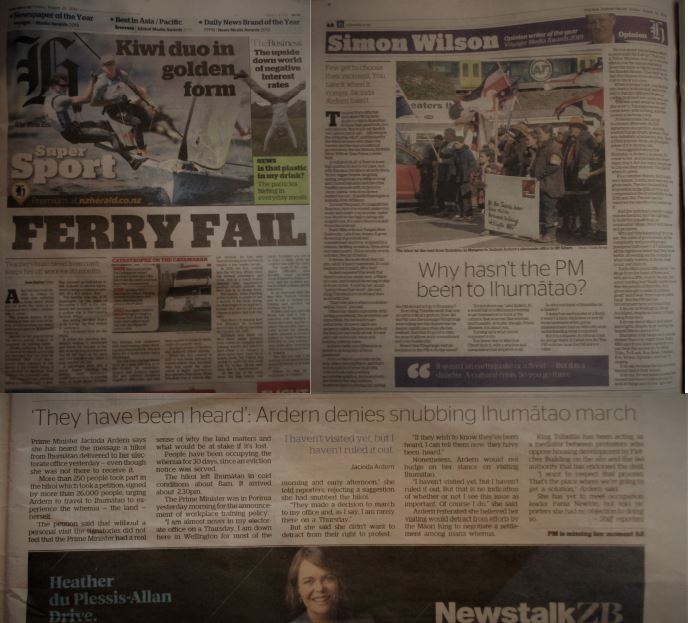
The New Zealand Herald could do better by running a lead story on its full size Saturday paper acknowledging that the newspaper has a poor legacy when it comes to its relationship with the indigenous people of New Zealand. For instance, in its 1963 100th anniversary edition, The New Zealand Herald bragged that the newspaper’s purpose was to promote a vigorous fight against the “Maoris”.
The paper was born in stirring times … waiting impatiently … for news of the first clash of arms between the British forces and the Waikato Maoris. In the outcome of the impending battle, the Herald had a special interest, for the very purpose of its existence was to provide a mouthpiece for those colonists who were demanding a more vigorous prosecution of the war.
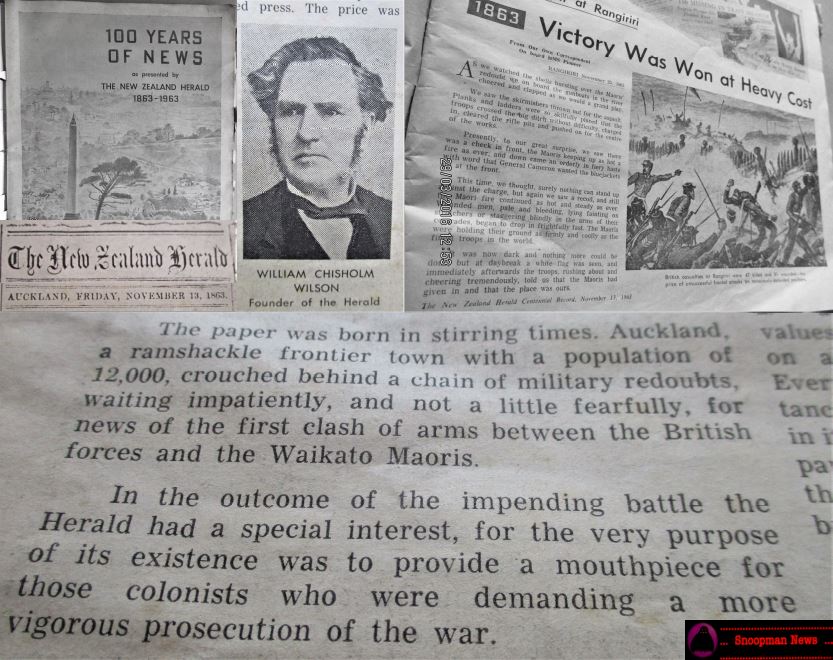
Because the Crown plays a delicate game wherein it avoids fessing up to New Zealanders that its alleged basis for sovereignty over New Zealand was not gained by the 1840 Waitangi Treaty, but rather through a war of conquest, the battle for the narrative over the Ihumātao land dispute is what will determine whether the Protect Ihumātao campaigners – most visibly led by Pania Newton – lose or win. For the organizing group, Save Our Unique Landscapes (SOUL), they want the land located adjacent to the mini-volcano, Puketaapapa, to be preserved rather than developed for housing. But, like all quests, a reappraisal of goals occurs as the protagonist identifies what is really going on, faces more setbacks and is almost defeated at turning point two. Since turning point two results from the unresolved conflict of turning point one, this event or development that leads directly to the ACT II climax, and propels the story into ACT III, acts like a structural support column of a bridge over a river or harbour. The Crown Police escalation of the night of August 5, when 400 supporters arrived en mass at the front-line, may have been turning point one, which in a story leads directly to the climax of ACT I. If this Police escalation resulted from machinations within the National Security State and Crown to raise the stakes and focus the Kiingitanga negotiations, then the ACT II climax may well turn out to be an event where the protagonist is defeated, though not permanently. Such set-backs, confrontations and learnings of the deeper machinations, often result in the protagonist pursuing a bigger goal.
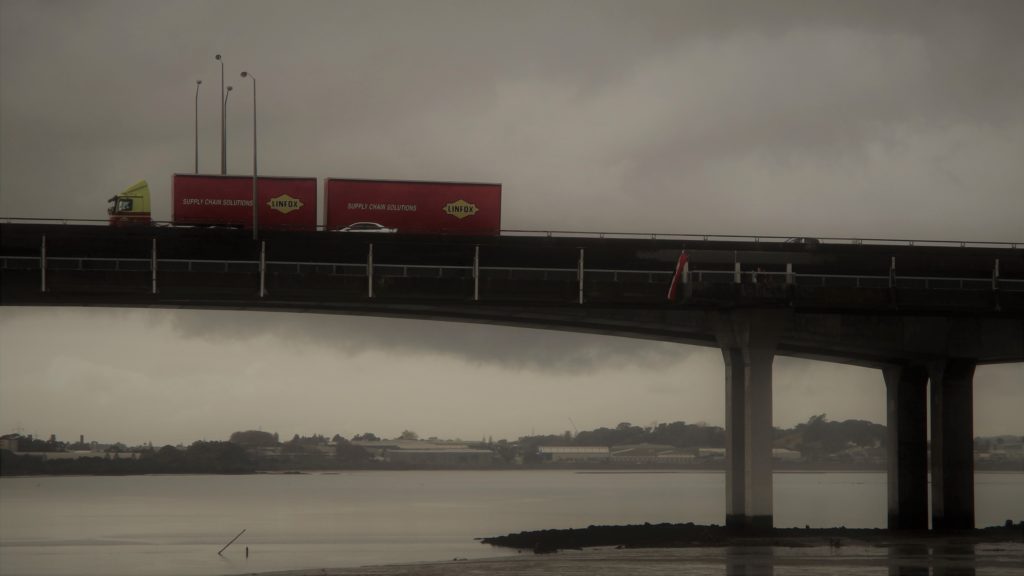
the Neo-Colonial Crown that could snowball out of its control if SOUL gains a land buy-back by the Crown and Auckland City Council with Native Title.
The Crown is playing a delicate game on behalf of the Pākehā-dominated ruling class by deploying polite racism to preclude openly buying back the land. Recall that the Crown and its National Security State lost the capacity to be overtly racist toward Māori following the backlash of the Police ‘Operation Eight’ Urewera raids of 15 October 2007, in which Tūhoe activist Tame Iti was accused of being a terrorist guerilla leader with a nationwide network? After creating a vindictive multi-season news special out of the Urewera Raids case, the Crown saved itself from losing jurisdiction over the Urewera wilderness, as The Snoopman showed in – Psy-warfare from Zaoui to Iti to Dotcom: Part 2 – Tame Iti as the Crown’s new scapegoat to resolve multiple crises. Tūhoe had a strong case for a return of their ancestral lands, especially as the iwi never signed the Treaty and therefore in a review of their case, it could not have been construed that they were in rebellion when their lands were confiscated during the ‘Great War for New Zealand’ of 1860 to 1872. Such an outcome would have been catastrophic for the Crown, because every other iwi and hapū would have demanded a return of mountains, lakes and rivers – regardless of whether they had settled or not.
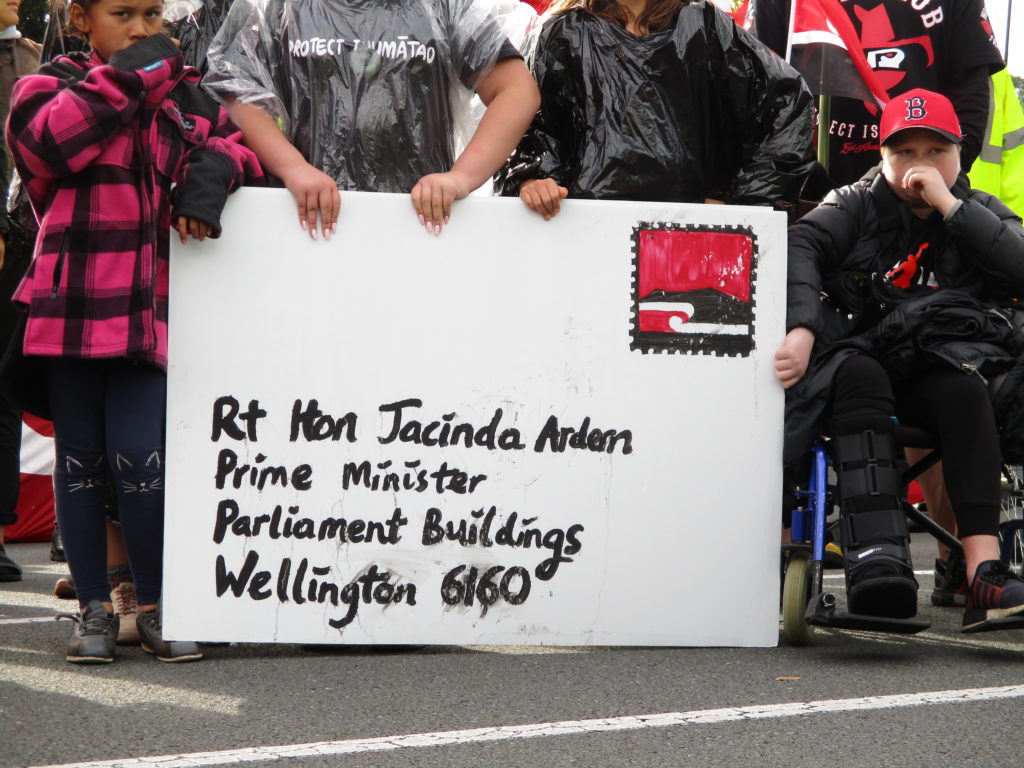
This loss to openly scapegoat Māori – which occurred between 2007 and 2017 – is huge, because the indigenous people of New Zealand had been treated as an enemy of the state since 1840. This is why the Pākehā ruling class have had to cultivate a more sophisticated form of polite racism.
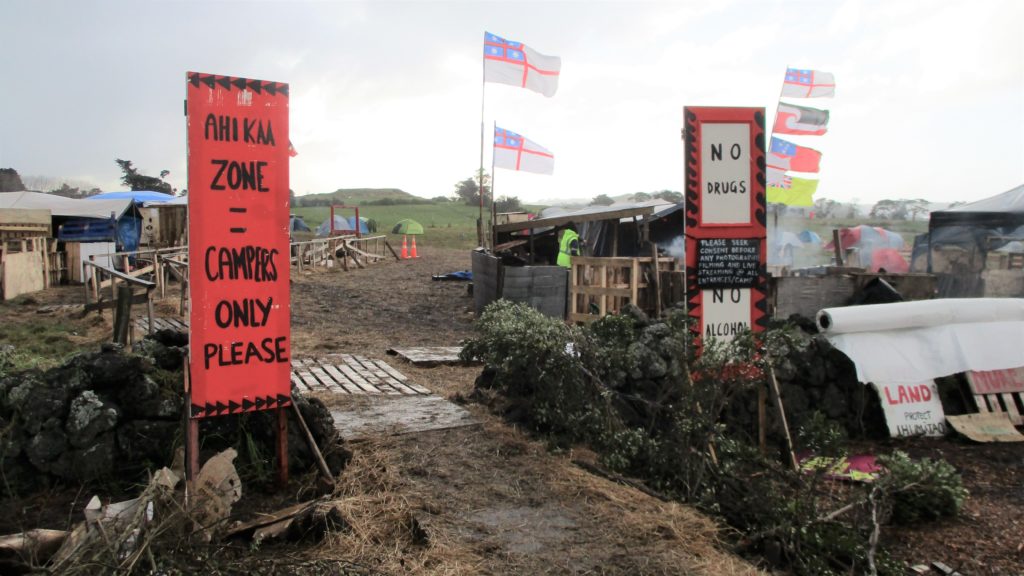
Therefore, whoever wins the battle over the narrative will determine whether the Neo-Colonial Game of transnational capitalism reigns supreme. Or, whether there is kaitiaki ahi kaa, or whenua guardians to keep the home fires burning at Ihumātao.
=====
Editor’s Note: If you find any errors, or you know of other cases where either the Crown or Councils have bought private land for purposes of returning such whenua to Māori, please send an email.
e: steveedwards555@gmail.com
